Remarketing lets you reconnect with people who have already bought something from you. Through personalized email campaigns. And advertising platforms like Facebook and Google Ads.
For example, a remarketing campaign email from Grammarly offers exclusive discounts to existing customers. To encourage them to renew or upgrade their plan.
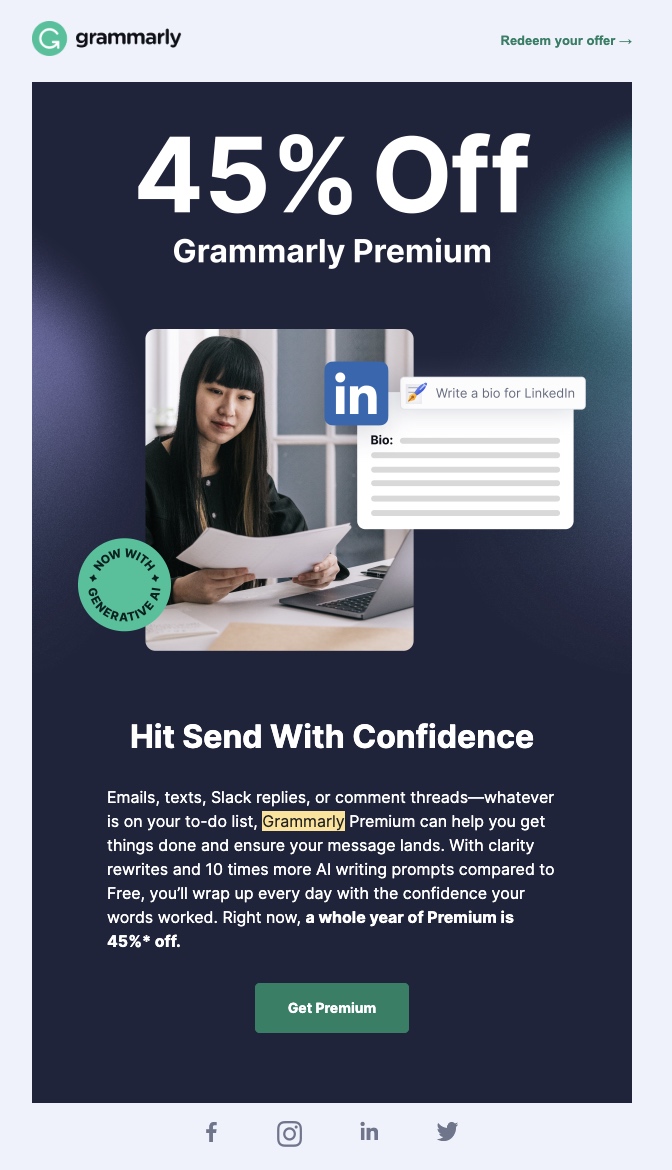
Remarketing focuses on reengaging your existing customers.
While retargeting aims to bring prospects back. These potential customers may have visited your website or engaged with your content. But didn’t complete a purchase.
Retargeting works by displaying relevant ads to these visitors as they browse other websites.
This tactic uses:
- Cookies: Small text files stored on a user’s device that remember their preferences and actions on a website
- Pixels: Tiny, transparent images on a webpage that track user behavior
Both strategies aim to reengage your audience.
But remarketing focuses on nurturing relationships with existing customers. And encouraging repeat purchases. Retargeting aims to convert potential customers by encouraging them to return to your website.
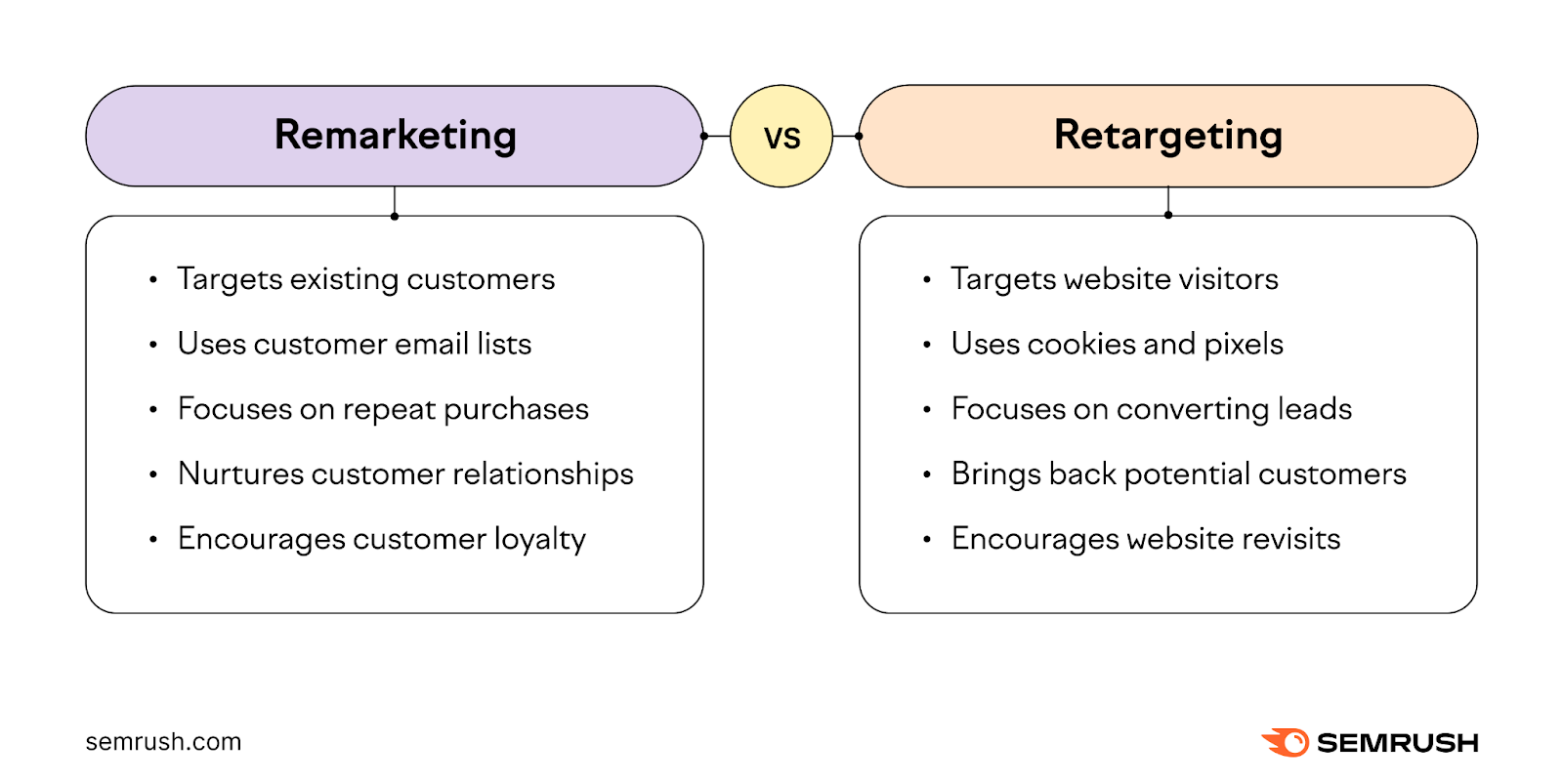
Google Ads, a leading advertising network, labels both remarketing and retargeting strategies as “remarketing” within its platform.
This has led to confusion. And conflicting definitions of these terms.
But the key difference is that remarketing relies on having a person’s contact information. Such as their email address. Which allows you to reach out to them directly.
While retargeting uses anonymous tracking methods to show ads to people who have interacted with your website. Even if you don’t have their contact details.
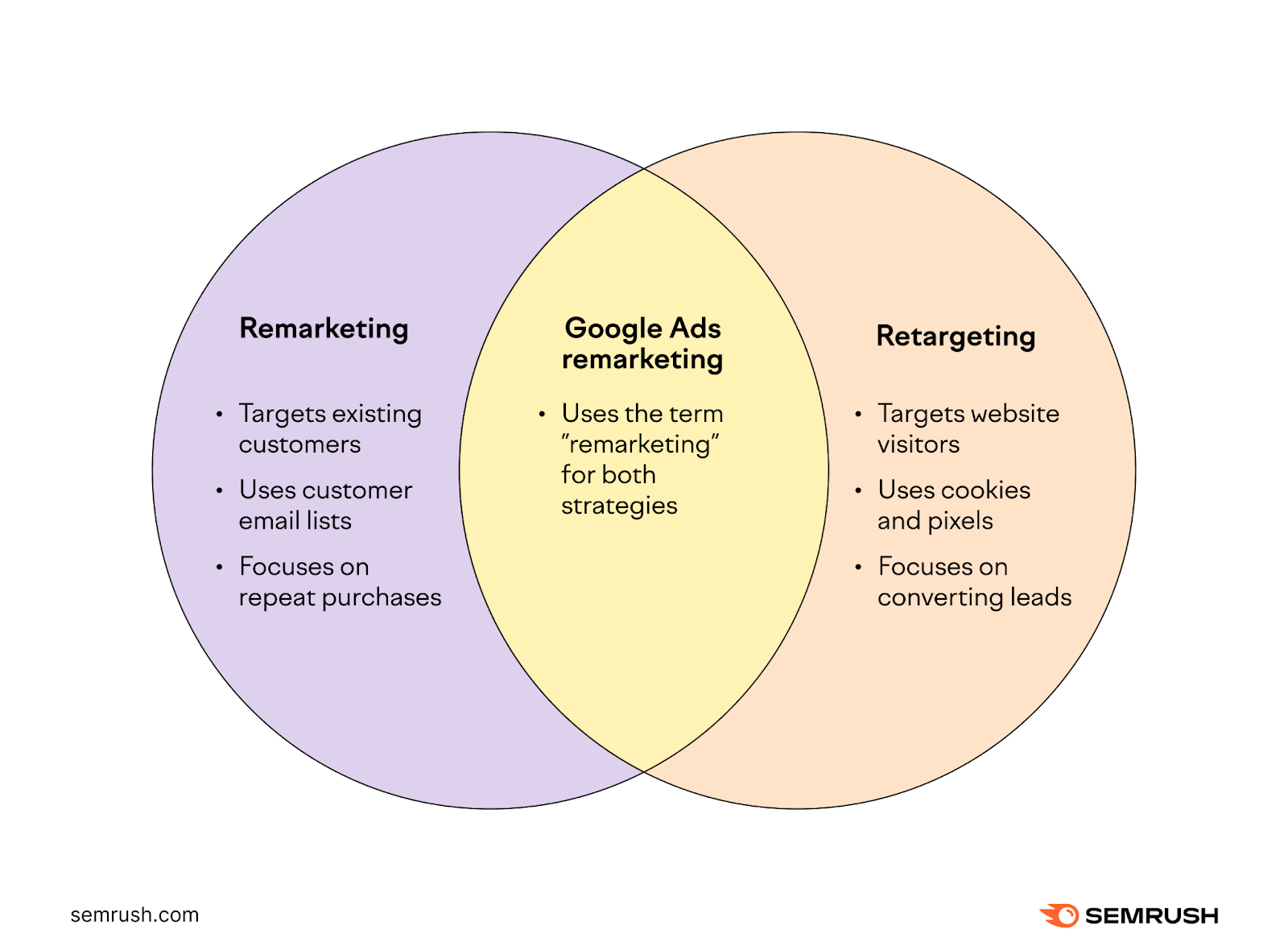
Remarketing works by leveraging existing customer data. To reengage customers through targeted email campaigns. Or personalized ads.
When someone makes a purchase on your website, their information is added to your customer database. This database includes their email address. And purchase history.
To show these customers targeted ads on other platforms, upload their email addresses to Google Ads, Facebook Ads, or other ad networks.
Here’s an option to upload your email list on Google Ads for your remarketing campaign:
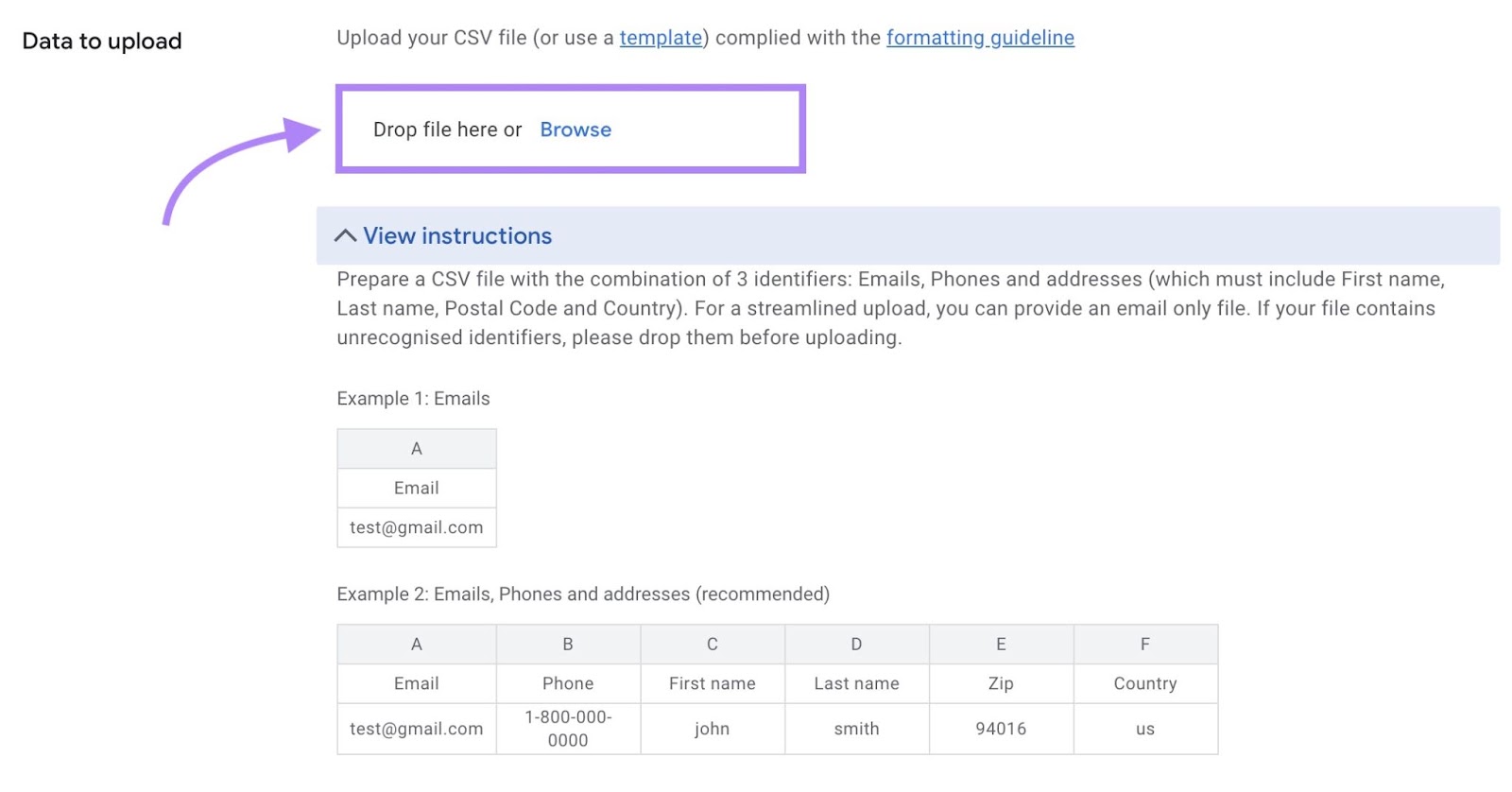
Here’s the same option on Facebook:
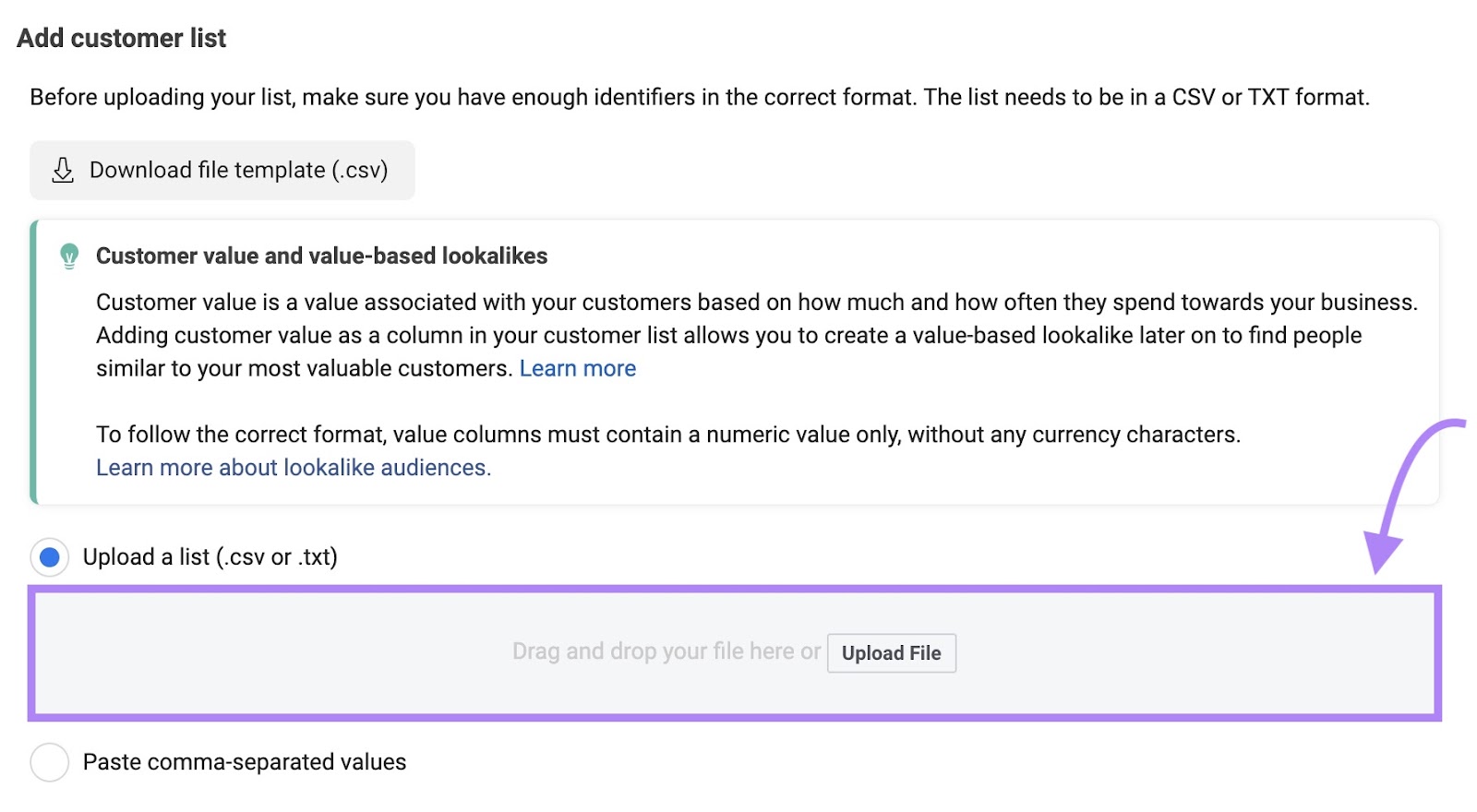
When you upload your email list, these platforms use a process called “matching” to find user accounts associated with the email addresses.
For example, if a customer’s email address is johndoe@gmail.com, Google Ads will look for a Google account with that same email address. Similarly, Facebook Ads will search for Facebook profiles using johndoe@gmail.com.
If a match is found, the platform will add that user to your remarketing audience without revealing any personal information.
This allows you to show personalized ads to your customers as they browse websites. Or social media apps.
- Stay top of mind: Remind customers about your brand even after they leave your site. Seeing your ads across websites improves brand recall. And sparks renewed interest.
- Personalize your messages: Create tailored ads for customers based on their purchase history. Showing them relevant products makes subsequent purchases more likely. And shows you understand their needs.
- Encourage repeat purchases: Bring past customers back by highlighting new arrivals or sales. Consistent outreach helps turn one-time buyers into regulars.
- Upsell and cross-sell: Suggest complementary products or higher-value items to customers based on past purchases. This can increase your average order value. And boost your revenue.
With their targeted nature, remarketing ads may also get higher conversion rates and greater efficiency than other advertising types. Because you’re reaching a highly engaged audience that has already used your product. This can boost your return on investments (ROI).
Several types of remarketing campaigns can help you reengage existing customers. Let’s look at the common types:
Email remarketing campaigns help you reconnect with your customers. And drive repeat sales.
They involve sending targeted emails based on a customer’s past interactions with your brand, such as:
- Products they’ve purchased
- Items left in shopping carts without buying
- How long it’s been since their last purchase
Create a highly personalized and engaging experience by tailoring your email content to each customer’s specific behavior. Encouraging them to return. And make another purchase.
There are three specific types of email remarketing campaigns:
Cart Abandonment Emails
Send cart abandonment emails to existing customers who add items to their online shopping cart. But leave your site without completing the purchase.
Cart abandonment emails remind customers they have items in their carts. And encourage them to return and complete their purchase.
To make these emails more compelling, include:
- High-quality images of the abandoned products
- Personalized recommendations for related items
- Limited-time offers. Such as discount codes or free shipping.
Here’s an example of an effective cart abandonment email from Javy, a coffee brand:
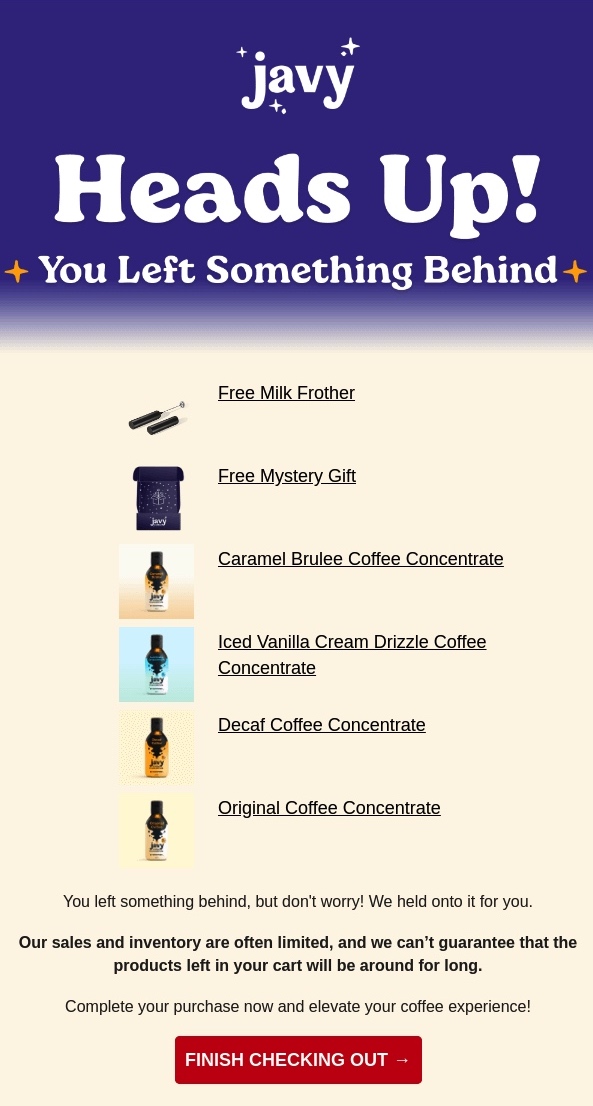
Post-Purchase Follow-Up Emails
Send post-purchase emails to customers after they’ve purchased from your store.
These emails are used in the following ways:
- Provide relevant information. Such as order tracking details and expected delivery dates.
- Recommend related products or accessories that complement the customer’s purchase
- Offer customer support. And addressing any potential concerns or questions.
Maintaining communication with your customers after a sale shows your commitment to providing good service. And building long-term relationships.
Check out this post-purchase email from pet company Chewy that asks for customer feedback:
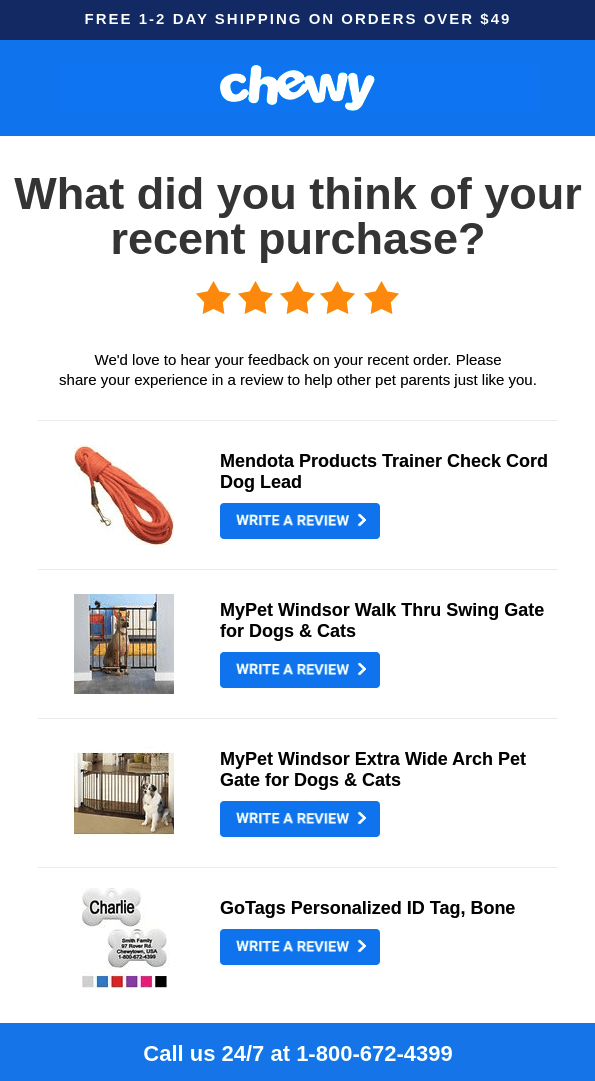
Win-Back Campaigns for Inactive Customers
Win-back campaigns (also known as reactivation campaigns) help reengage customers who haven’t made a purchase or interacted with your brand in a long time.
These customers may have forgotten your brand, found an alternative solution, or lost interest.
To create an effective win-back campaign, segment your inactive customers based on their past purchase behavior. And the length of their inactivity.
Next, create targeted email messages that:
- Acknowledge the customer’s absence and express your desire to win back their business
- Highlight new product offerings, features, or improvements that have been made since their last interaction
- Include a special offer, such as a discount code, to incentivize them to buy again
- Ask for feedback to better understand why they became inactive. And how you can improve their experience.
Here’s a reactivation email from vintage homeware store Bougie that offers a free gift card on every new order to reactivate dormant customers:
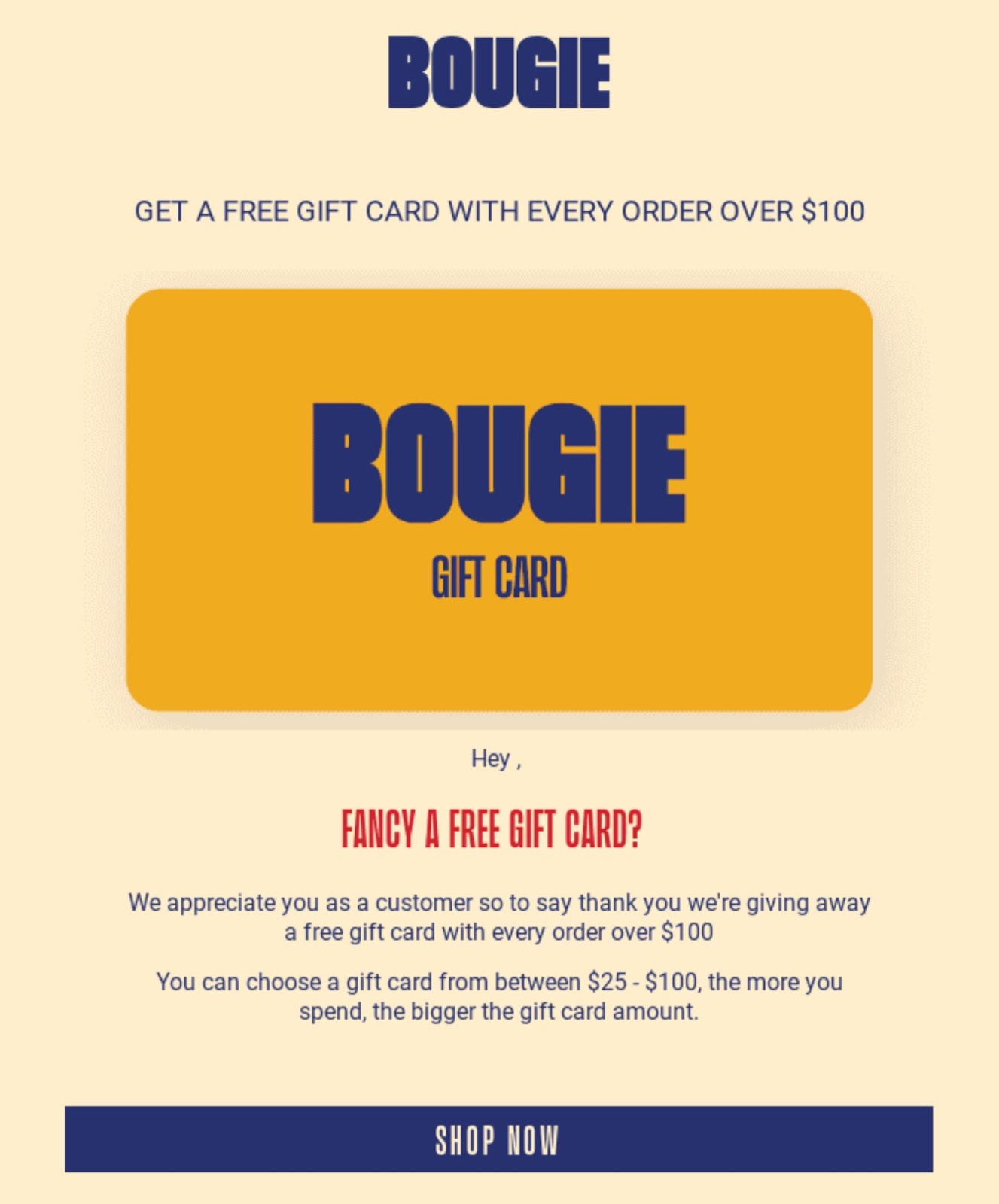
Google’s remarketing tools include remarketing and retargeting capabilities.
This means you can use Google Ads to show targeted ads to your existing customers (called “customer match”).
To use Google’s remarketing feature, upload your customer list to Google Ads.
Google will match the email addresses with Google accounts. Enabling you to serve ads to these customers across various Google platforms.
Let’s look at different types of Google Ads remarketing campaigns you can run using customer lists:
Display Ads on Google Display Network
The Google Display Network (GDN) is a network of websites, apps, and videos where your display ads can appear.
For example, here’s a display ad on Forbes’ website, which is a part of the GDN:
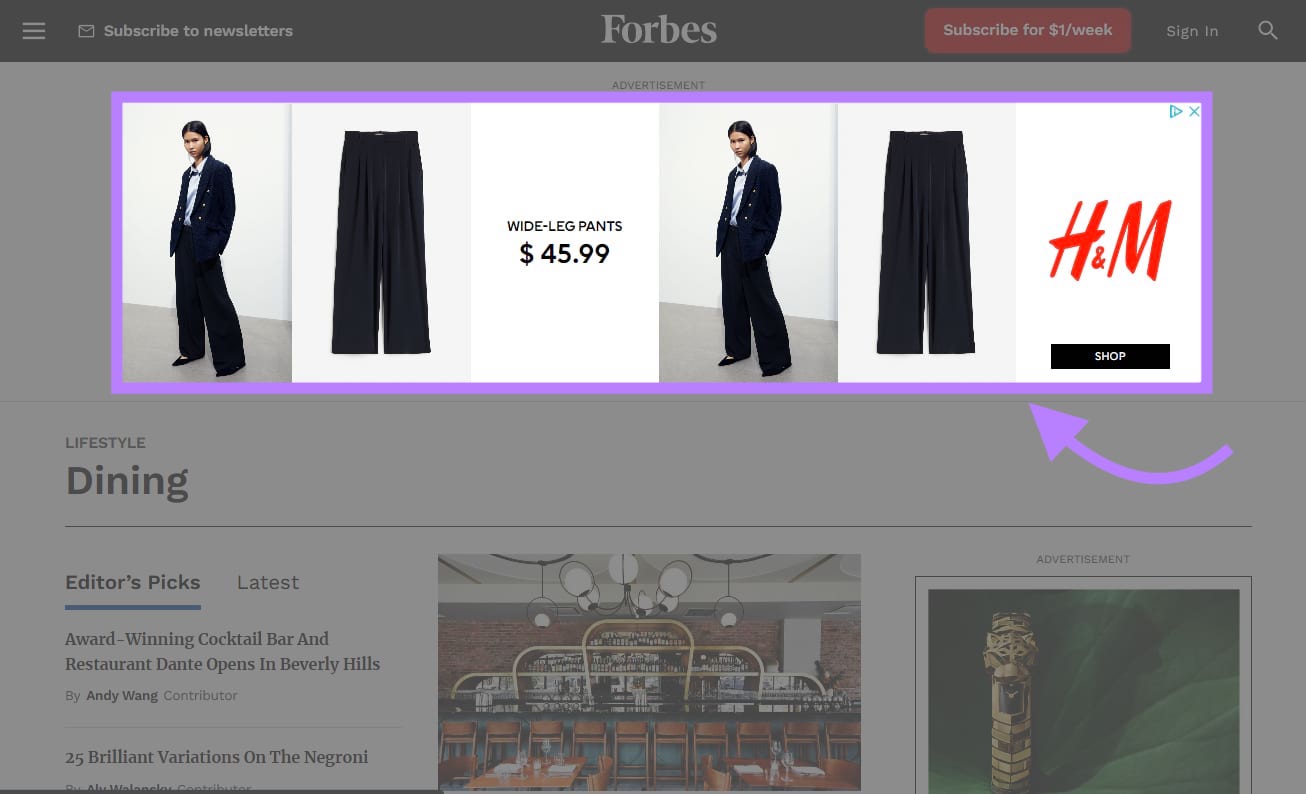
With remarketing, you can show visual ads to your customers as they browse third-party sites. Or use apps that are part of the GDN.
To create effective display ads for remarketing:
- Use high-quality, eye-catching images or videos that align with your brand
- Include a clear, compelling message. And call to action.
- Experiment with different ad sizes and formats to find what works best for your audience
You can also look into your competitors’ display ad campaigns to learn from their approach.
Analyze the types of display ads and visuals they’re using. And examine the amount of money they’re spending and their overall messaging.
Even looking at non-remarketing campaigns will give you a deep understanding of what works in the real world. And how you should capture the attention and interest of your target audience effectively.
Use Semrush’s AdClarity, a competitive intelligence app, to analyze your competitors’ display ad campaigns in more detail.
The app shows various data points. Like estimated expenditure and impressions, ad buying methods, top campaigns, and ad placement distribution.
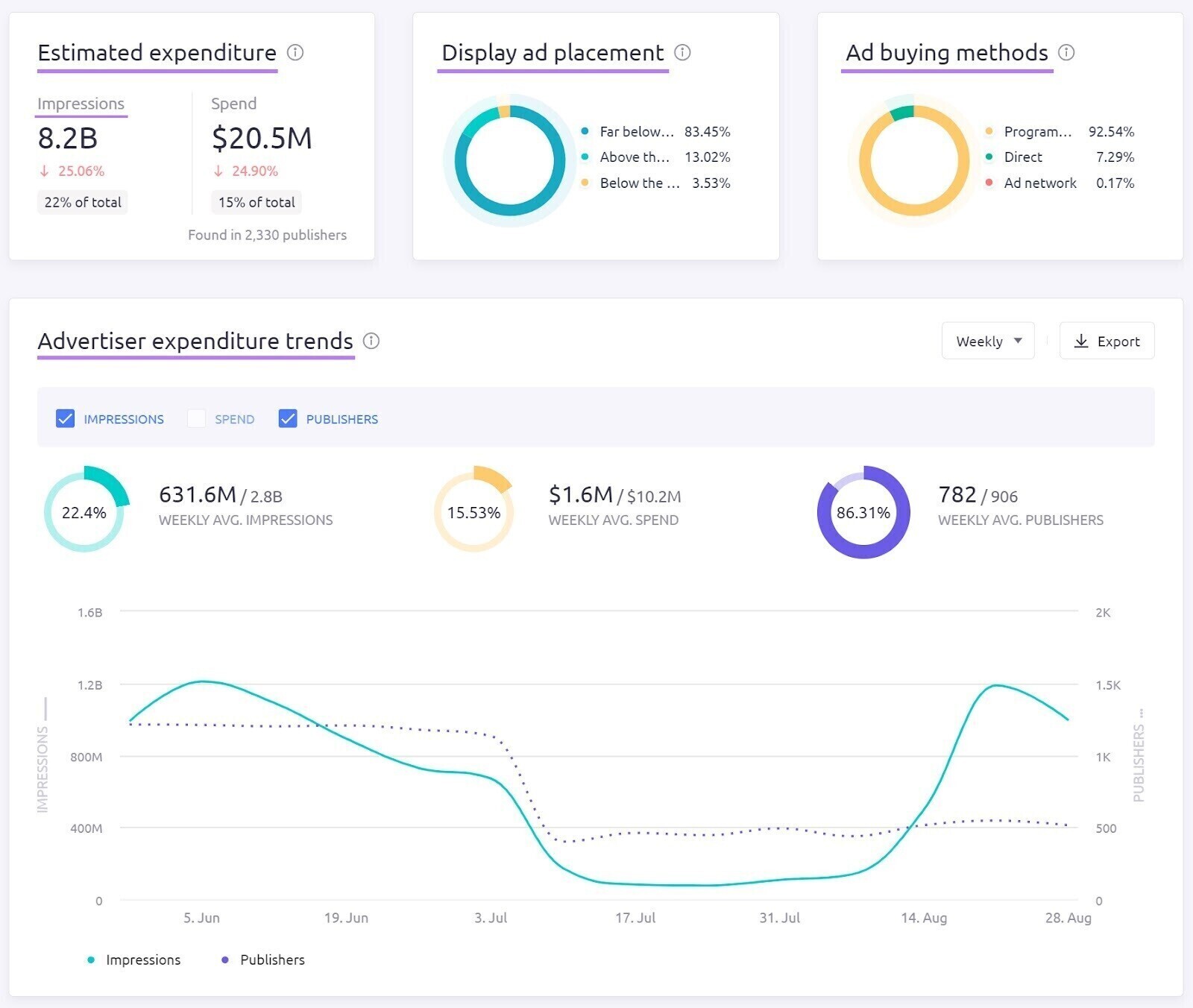
Use these insights to create more effective remarketing display ads.
For example, suppose a competitor is heavily investing in Facebook carousel ads that showcase multiple products. Test a similar format for your remarketing campaigns to see if it drives better results than single-image ads.
Or, if you see a competitor’s display ads frequently appearing on certain websites or mobile apps, take note of those placements. Consider targeting the same placements for your ads to reach a similar audience.
Search Ads on Google Search Network
Google search remarketing ads allow you to show text ads to your customers when they search for keywords related to your business on Google.
Here’s how a typical search ad looks:
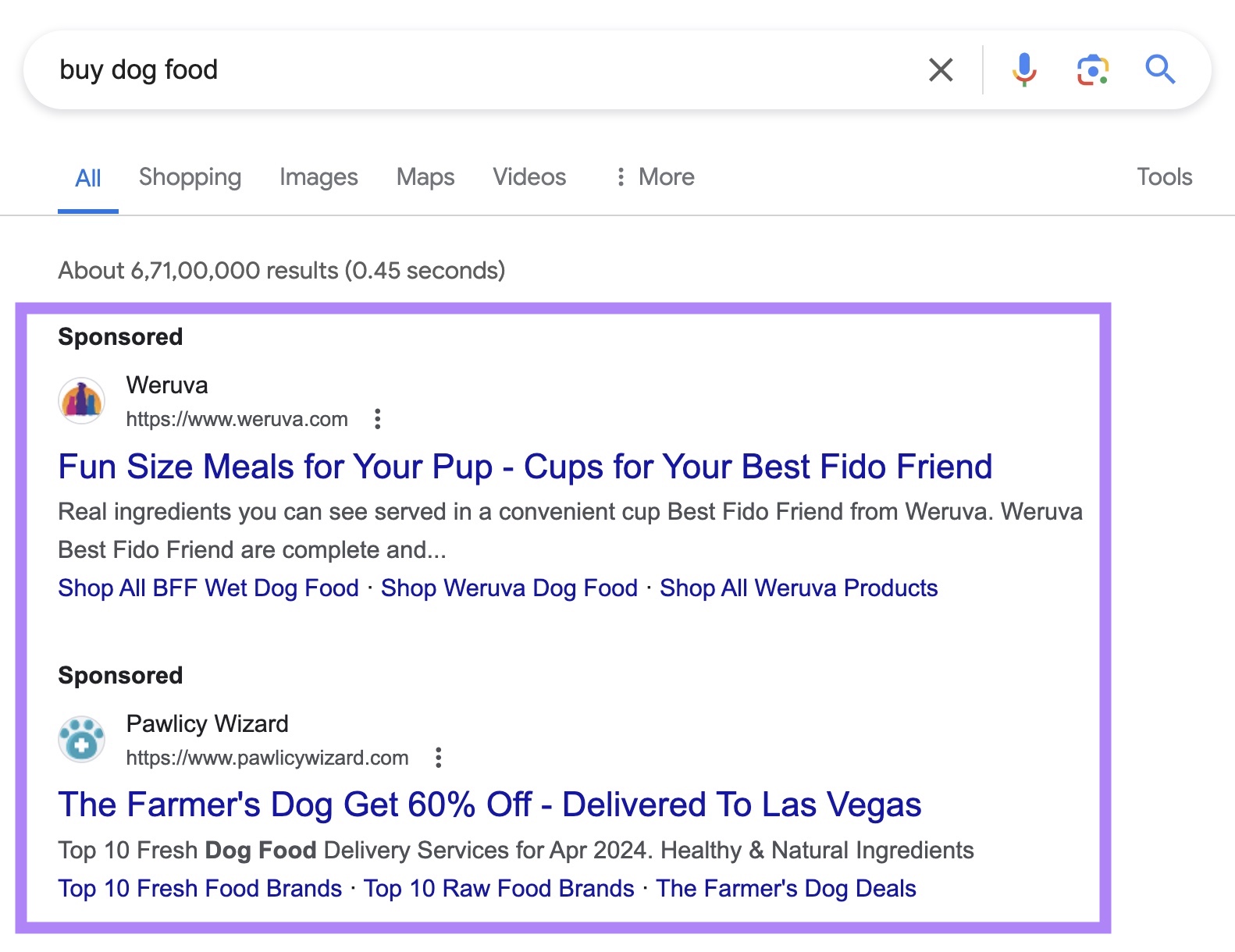
These remarketing ads can help you capture your customers’ attention when they’re actively looking for products like yours.
Follow these remarketing search ads best practices
- Include relevant keywords in your ad copy. To match customers’ search queries.
- Use a strong, clear call to action to encourage clicks
- Highlight your unique selling points (USPs)
- Optimize your ad performance based on click-through rates (CTR). And conversion rates.
Use our Keyword Magic Tool to find relevant keywords.
Open the tool, enter your seed keyword (a broad term related to your business), and choose your target location. Click “Search.”

You’ll see a list of thousands of keyword ideas.
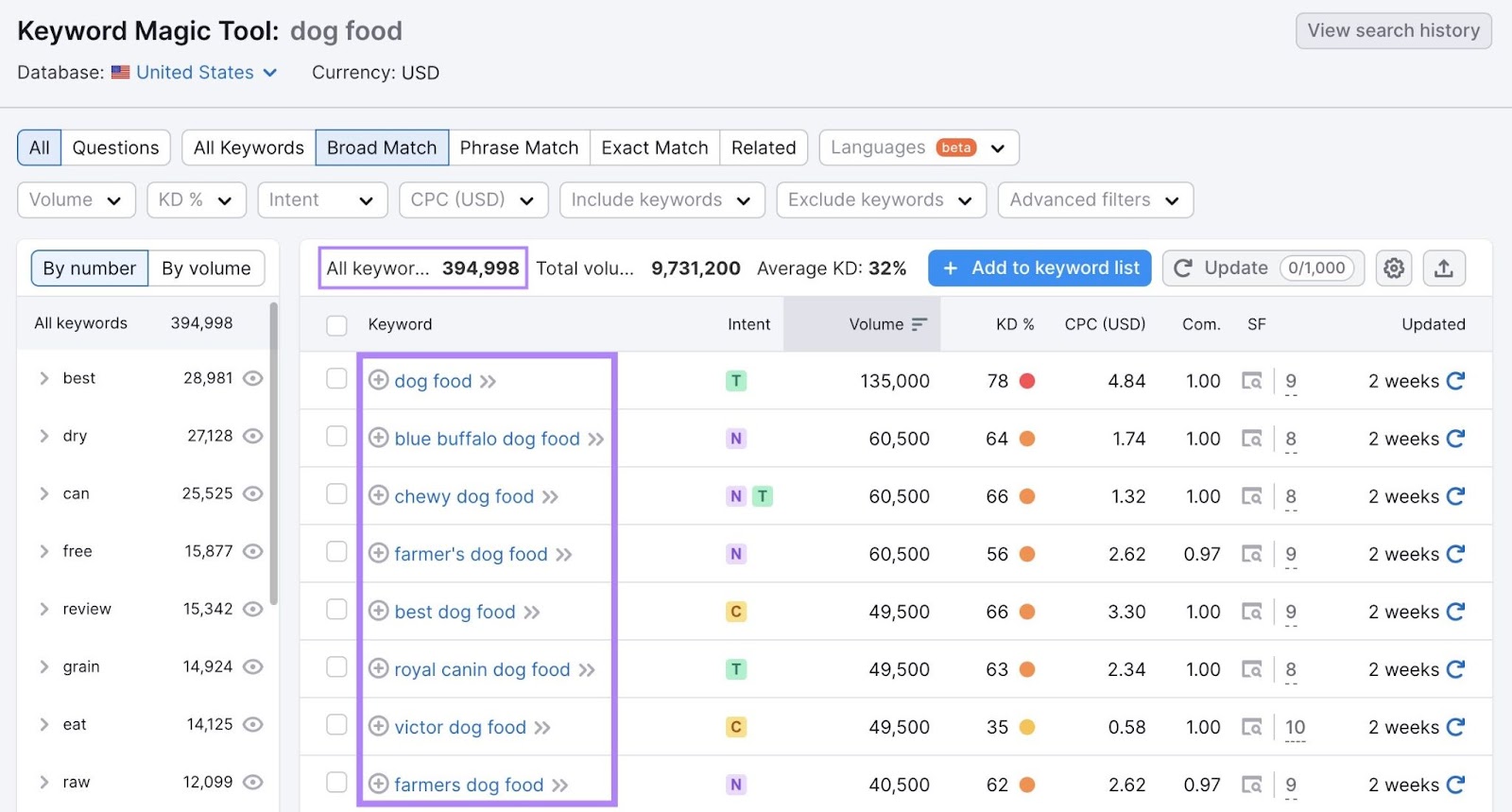
Narrow this list with filters.
Use the “CPC (USD)” filter to find keywords in your budget. Set a custom range of the amount you’re willing to pay per click.
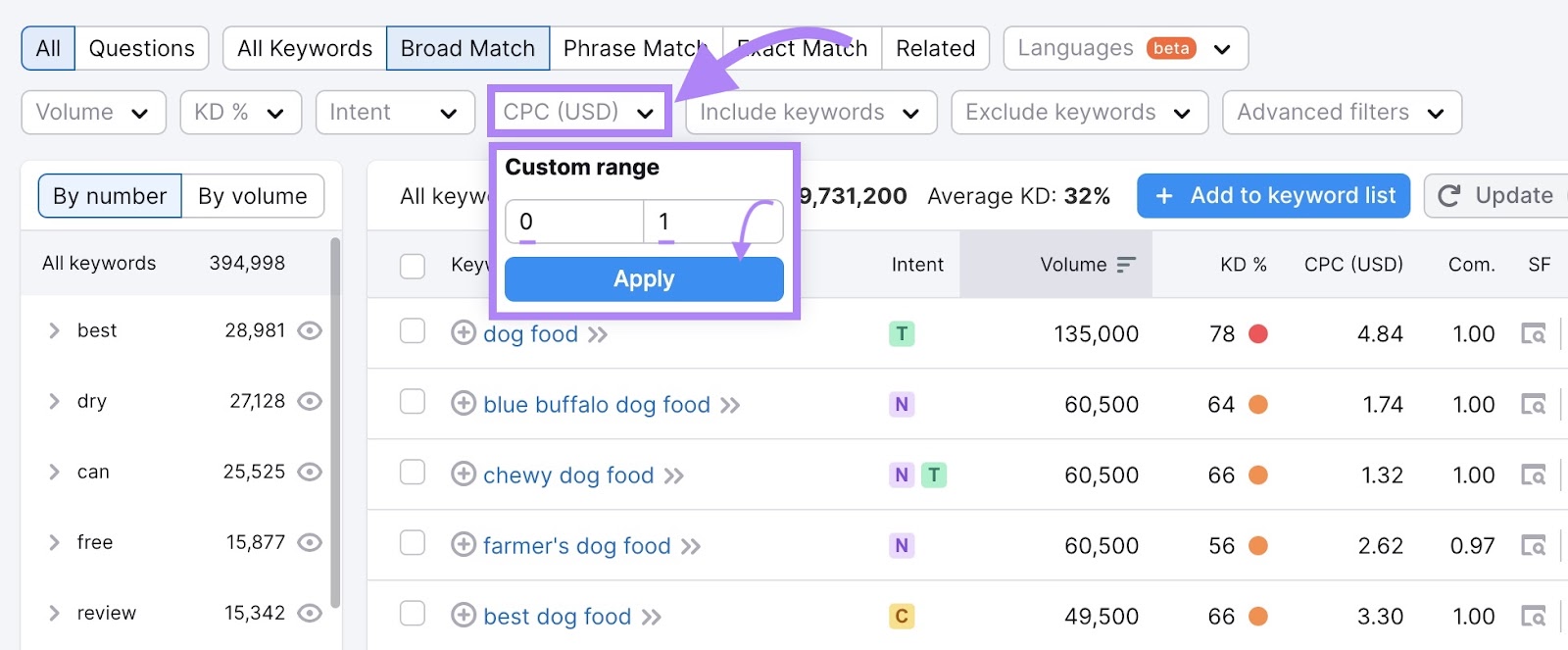
Next, choose keywords that are less competitive (but have decent search volume). Use the “KD%” (keyword difficulty percentage) filter.
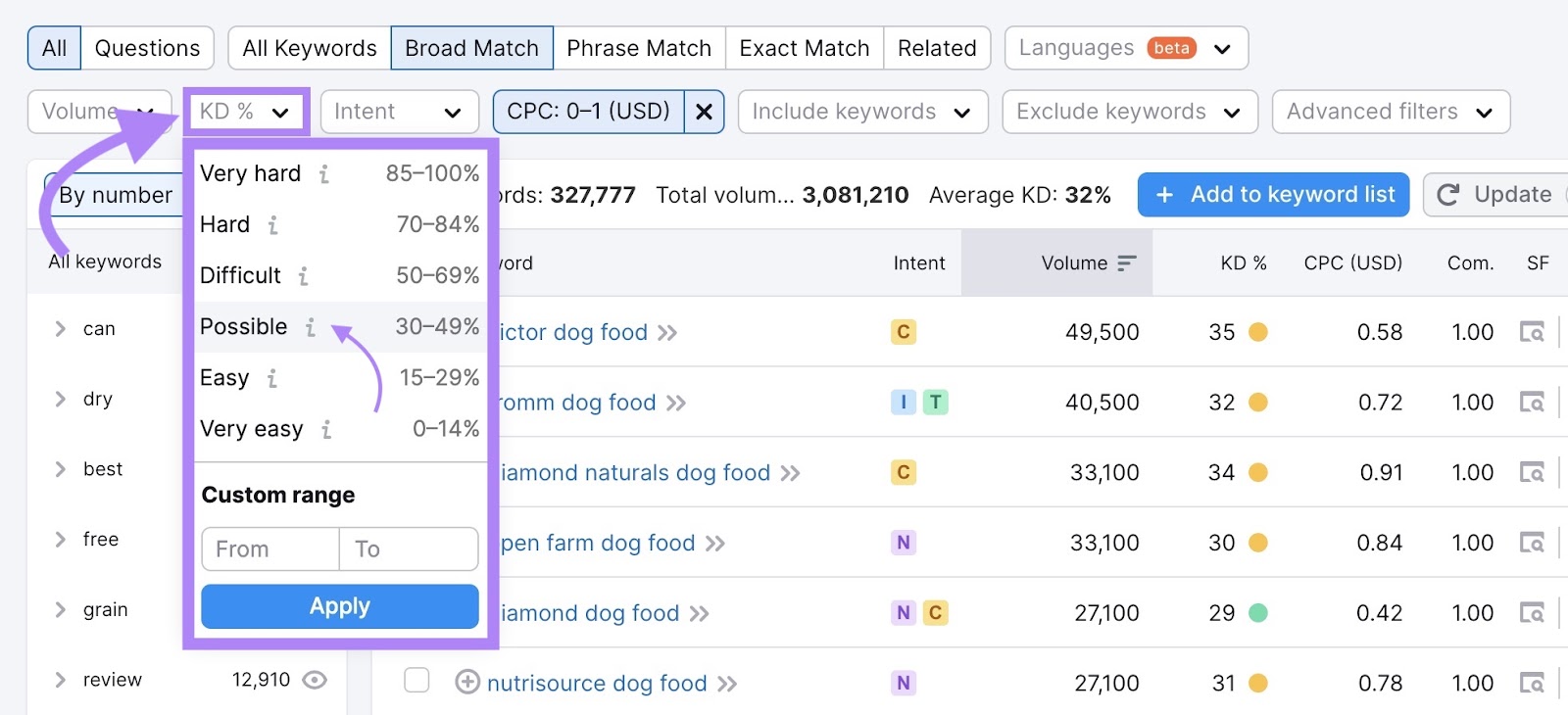
After applying relevant filters, review the final list of keyword ideas. Choose keywords that make sense for your Google search ad campaign.
YouTube Video Ads
YouTube remarketing allows you to show video ads to your customers as they watch videos on the platform.
Here’s an example of a YouTube ad playing before the actual video starts:
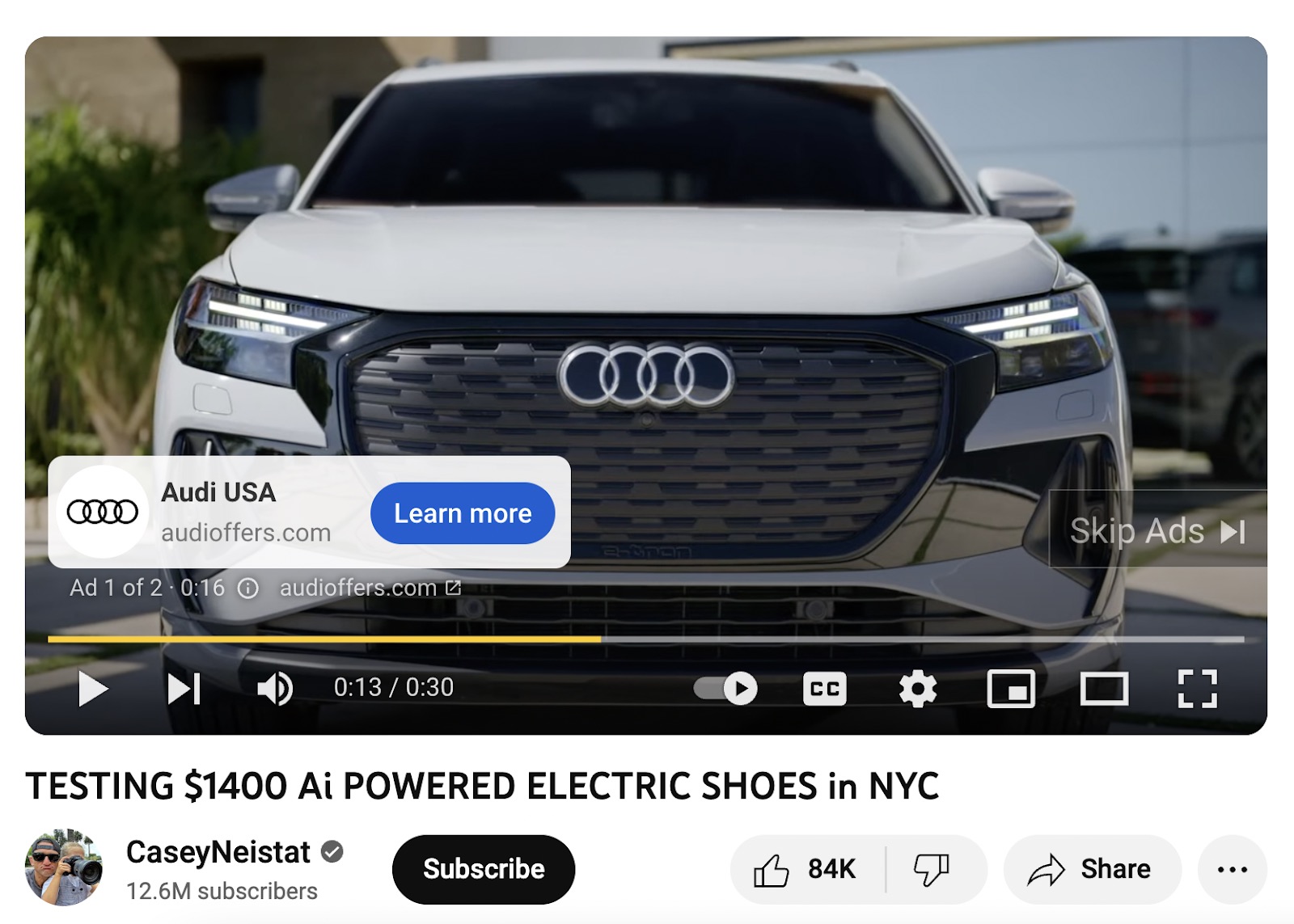
Use these tips to create impactful YouTube video ads for remarketing:
- Develop engaging, informative, or entertaining video content that resonates with your target audience
- Keep your videos concise and attention-grabbing. Especially for shorter ad formats.
- Include a clear call to action (e.g., “Shop now,” “Learn more”). And make it easy for viewers to take the desired action.
Upload your customer email list to social media platforms. To create targeted ads that will be shown directly to customers as they scroll through their social media feeds.
Social media remarketing allows you to combine the effectiveness of remarketing with the extensive reach and precise targeting options of social media ad platforms.
Here are the top platforms where you can run remarketing campaigns:
Facebook and Instagram Remarketing Ads
Facebook and Instagram let you create remarketing ads in various engaging formats.
Upload your customer list to Ads Manager to create custom audiences.
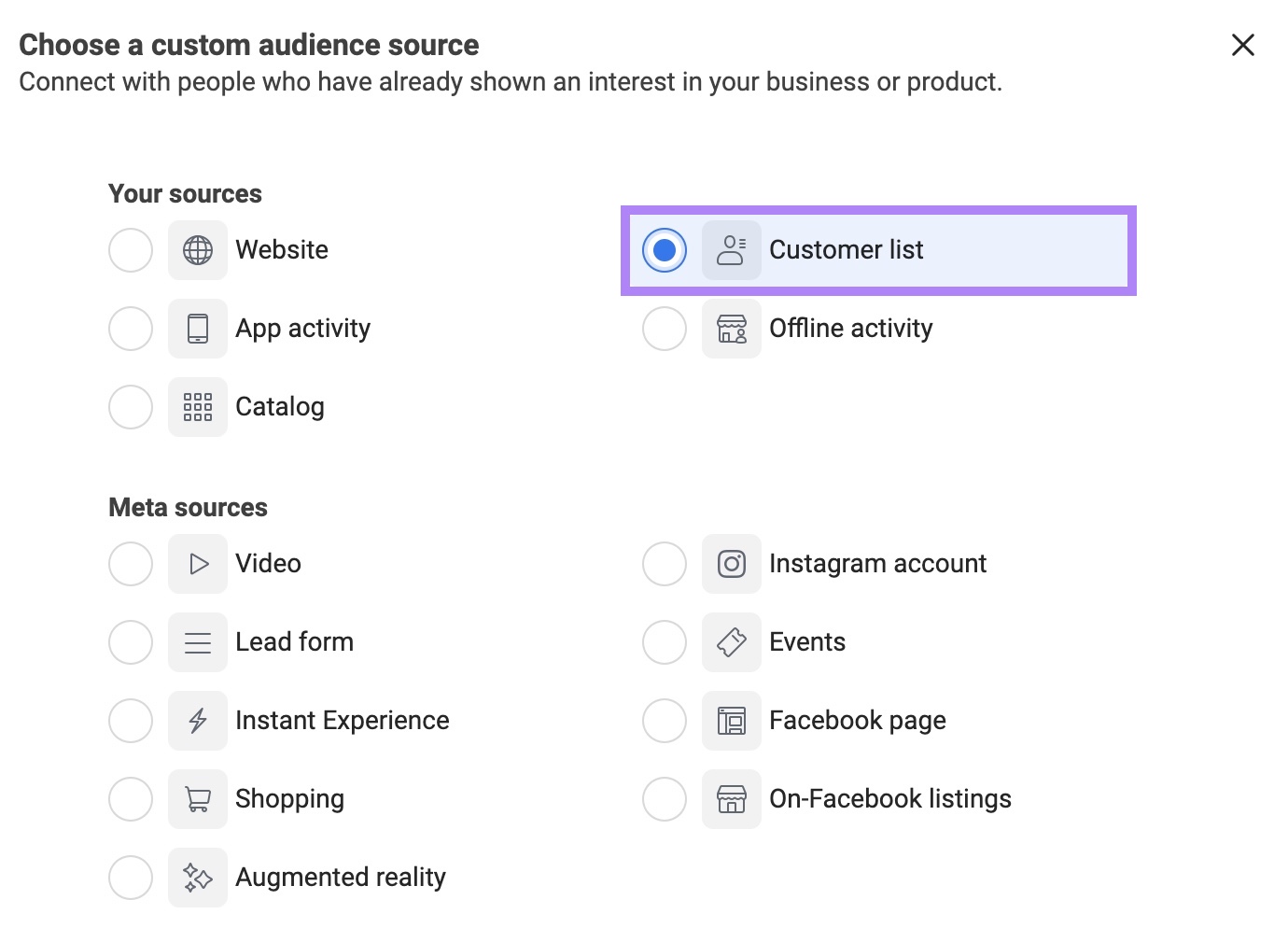
Your ads can appear seamlessly in your customers’ feeds as they browse either platform.
Common ad formats for remarketing on Facebook and Instagram include:
- Single image or video ads: Showcase your best products, services, or promotions
- Carousel ads: Allow customers to swipe through images or videos. This is ideal for storytelling or featuring multiple products.
- Collection ads: Highlight a product line with a main image or video and related product images
- Stories ads: Full-screen ads appearing between user stories, designed to capture attention
Maximize the impact of your Facebook and Instagram remarketing ads by following these best practices:
- Use visually compelling images or videos that grab attention
- Write clear, concise ad copy that highlights your USP. And includes a strong call to action.
- Monitor your ad performance regularly. And make data-driven adjustments to optimize results.
LinkedIn is ideal for remarketing if your business targets professionals. Or operates in the B2B space. You can reach and reengage your customers in a professional context.
To create LinkedIn remarketing ads, upload your customer list to LinkedIn Campaign Manager.
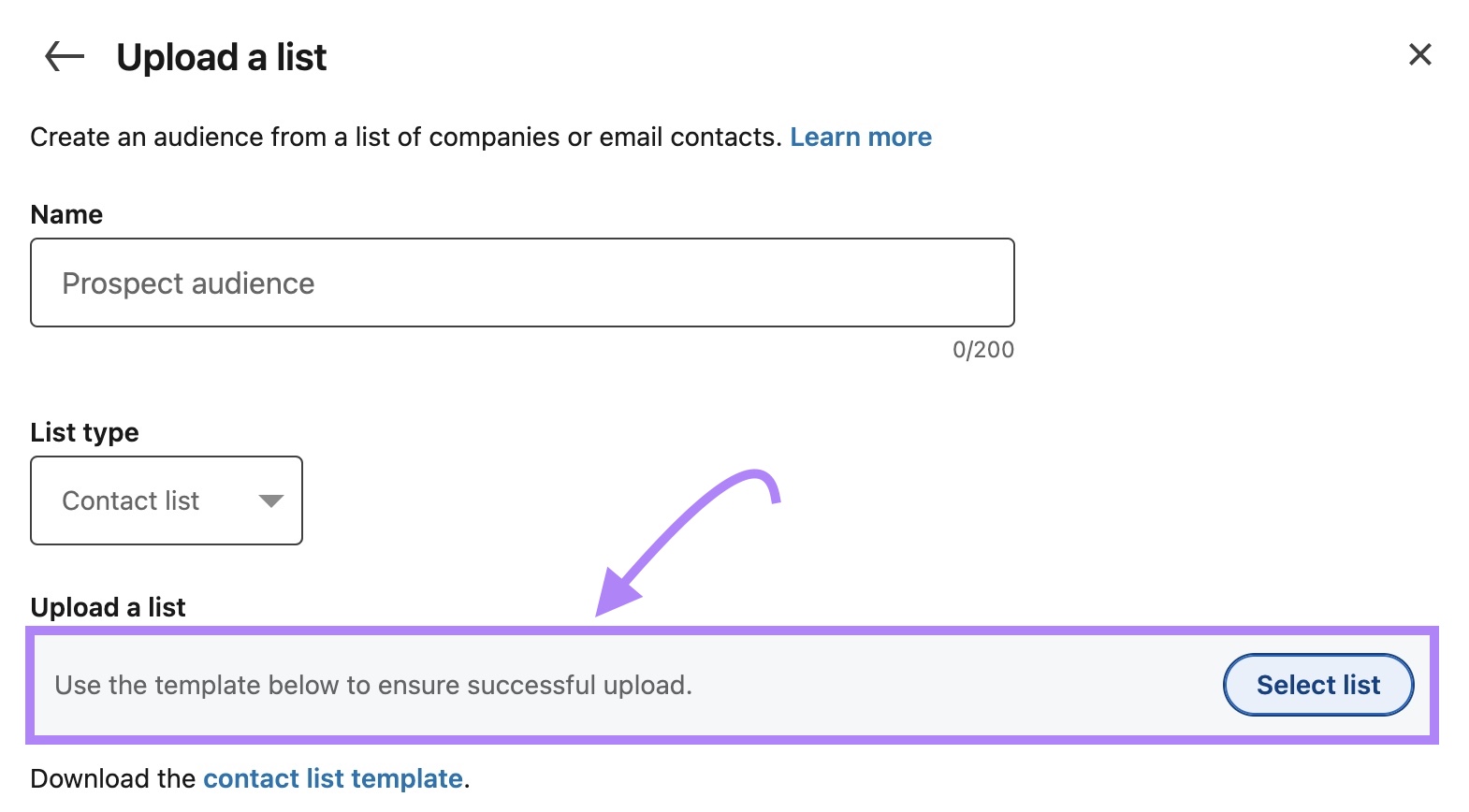
Then, choose from ad formats like:
- Sponsored content: Ads appear directly in your customers’ LinkedIn feeds, blending with the platform’s organic content. They can have attached images and videos.
- Text and dynamic ads: Ads that can be customized based on your customers’ profile information
- Sponsored InMail: Deliver personalized messages to your customers’ LinkedIn inboxes
Follow these tips to create effective LinkedIn remarketing ads:
- Tailor your ad content to the professional tone of LinkedIn
- Clearly communicate how your products benefit businesses or professionals
- Test different ad formats and content variations to determine what resonates best with your audience
X’s fast-paced nature makes it great for reaching customers with short, impactful messages.
Upload your customer list to X Ads Manager. Then, create remarketing campaigns to show your ads to customers as they use the platform.
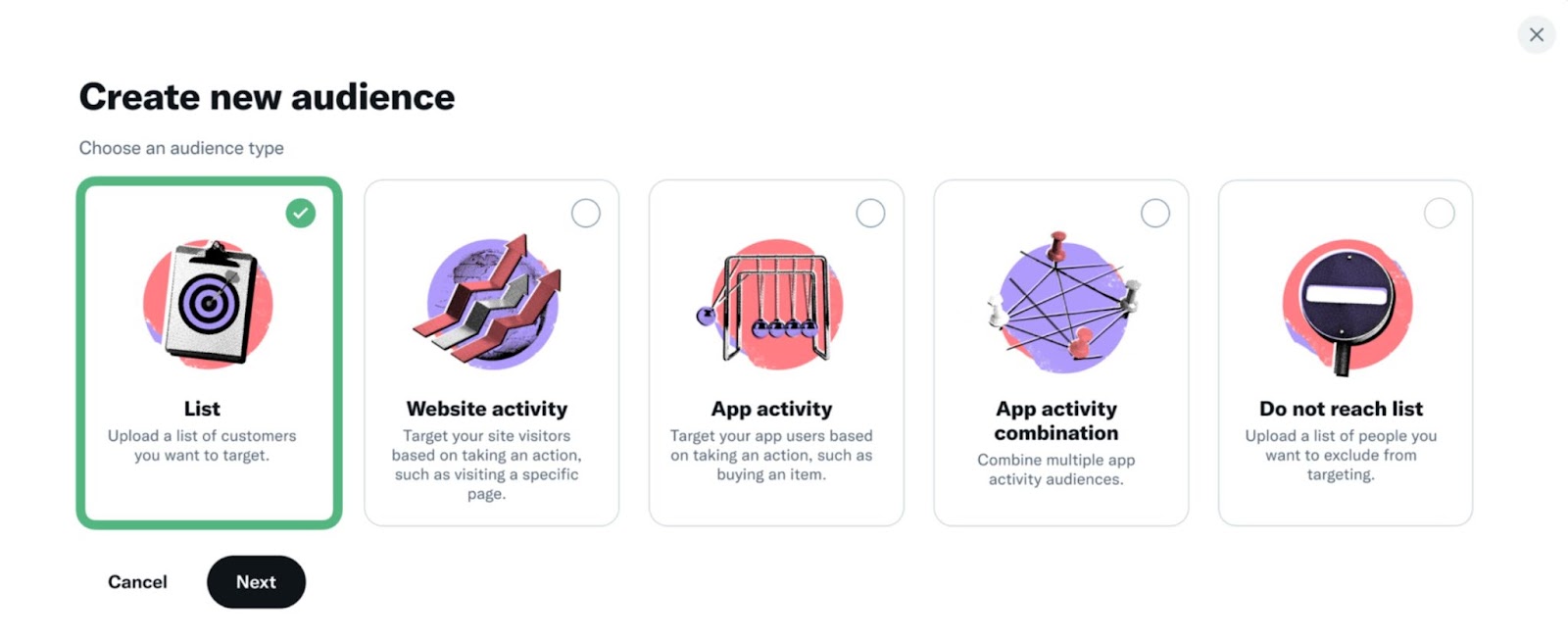
Common X ad formats for remarketing campaigns include:
- Promoted posts: Ads appear in your customers’ X feeds, integrating with the organic content they consume
- Promoted accounts: Suggests your X profile to your customers as an account to follow. Helping you expand your reach.
- Promoted trends: Showcase your brand or campaign hashtag at the top of the Trending Topics list
Follow these tips for creating successful X remarketing ads:
- Keep your ad copy concise, attention-grabbing, and easy to read
- Use eye-catching visuals like images, GIFs, or short videos to make your ads stand out
- Actively engage with customers who interact with your ads. By liking, retweeting, or replying to their comments.
Further reading: The Beginner’s Guide to Social Media Advertising in 2024
SMS remarketing campaigns allow you to send targeted text messages to your customers’ mobile phones. For highly personalized communication.
This direct approach can lead to higher engagement and conversion rates compared to other marketing channels.
Here’s an example of SMS marketing from Adore Me, a lingerie brand:
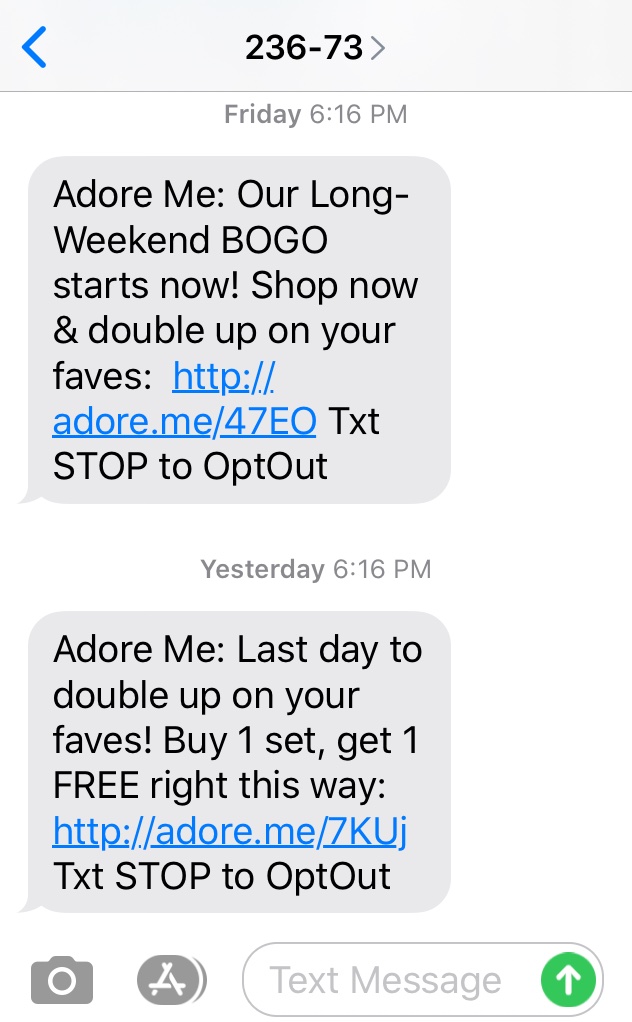
While remarketing typically focuses on reaching customers through email, you can also use the phone numbers you’ve collected to send personalized SMS messages.
These messages can include special offers, discounts, or other promotional content tailored to your customers’ interests and preferences.
Google’s remarketing program allows you to target existing customers through email lists. And website visitors who haven’t purchased yet.
To create a Google Ads remarketing campaign that targets your customers, you’ll need to:
- Create a remarketing list of people you want to reach
- Create your ad campaign
Let’s start with creating your remarketing list.
Sign in to your Google Ads account. And go to “Tools” > “Shared library” > “Audience manager.”
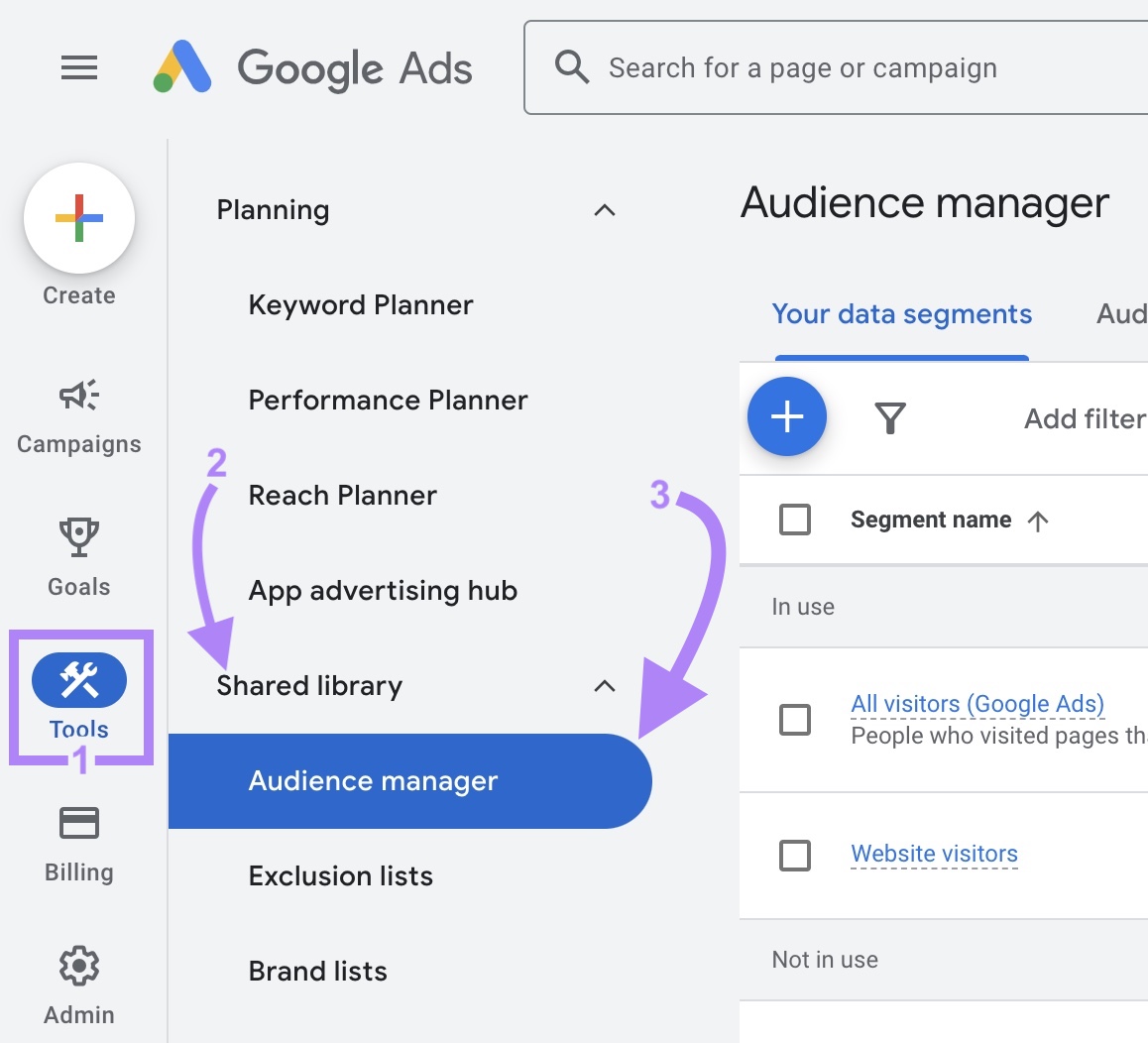
Click the “+” icon and select “Customer list” to create your remarketing list.
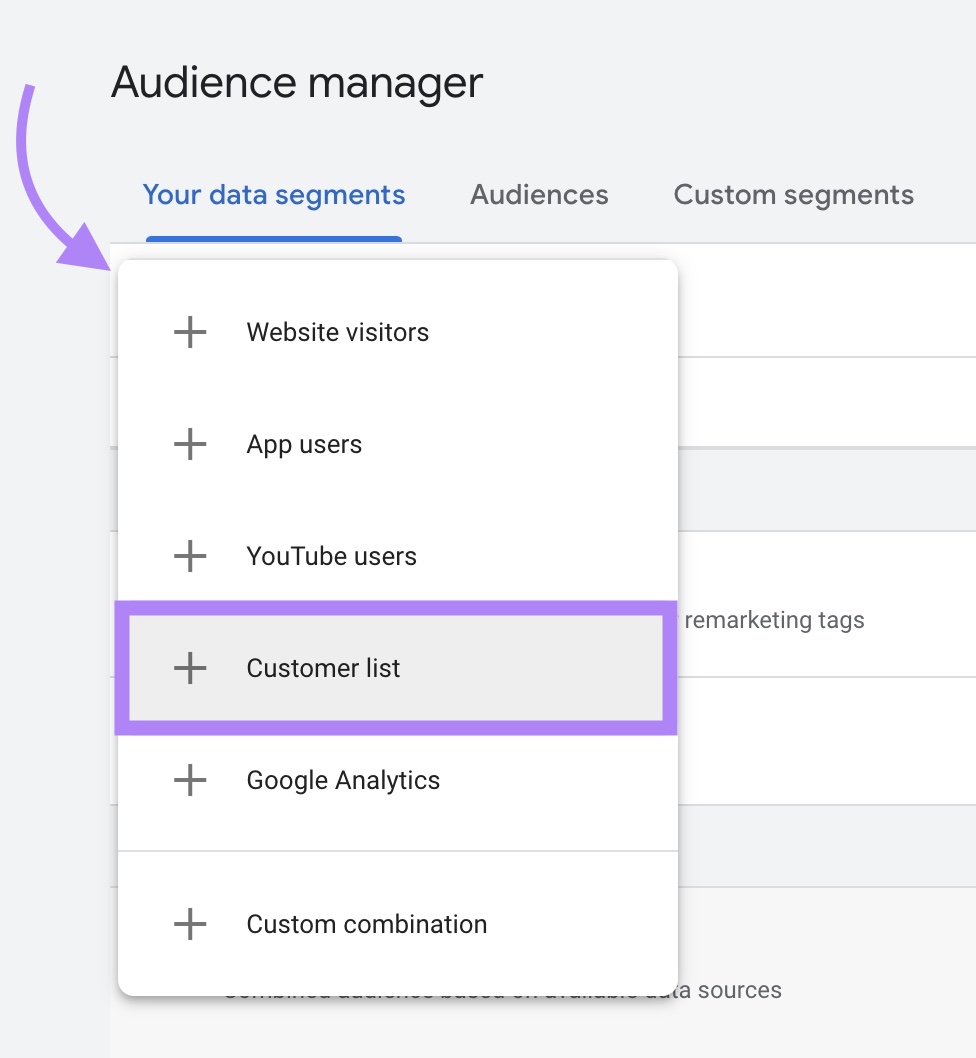
Choose your data source. This determines how you will upload your customer data to create the remarketing list. Select “Upload a file manually.”
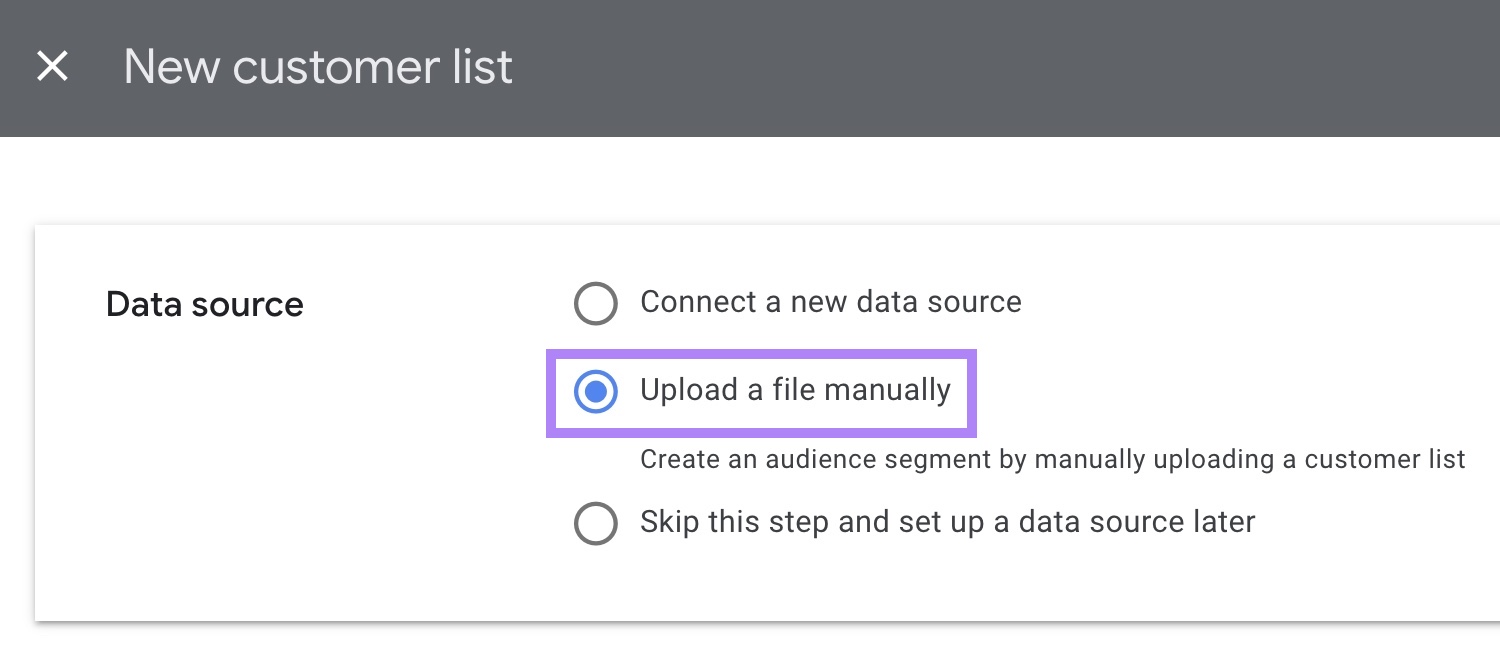
Name your audience segment, select a data type, and upload the CSV file containing your customers’ email addresses. Then, click “Save and continue.”
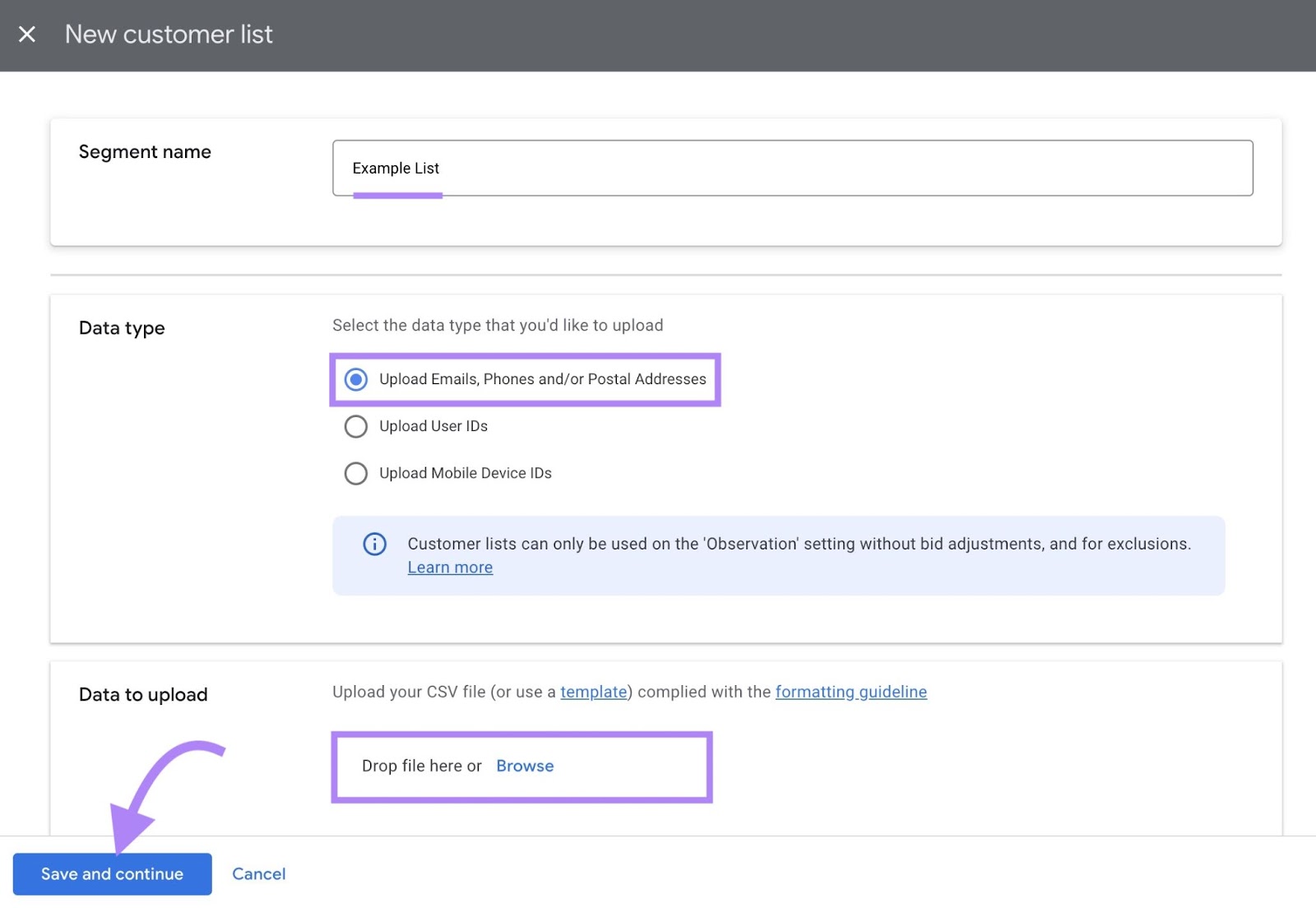
Once your list is uploaded successfully, Google will take up to 24 hours to match the email addresses in your file with Google accounts associated with those addresses.
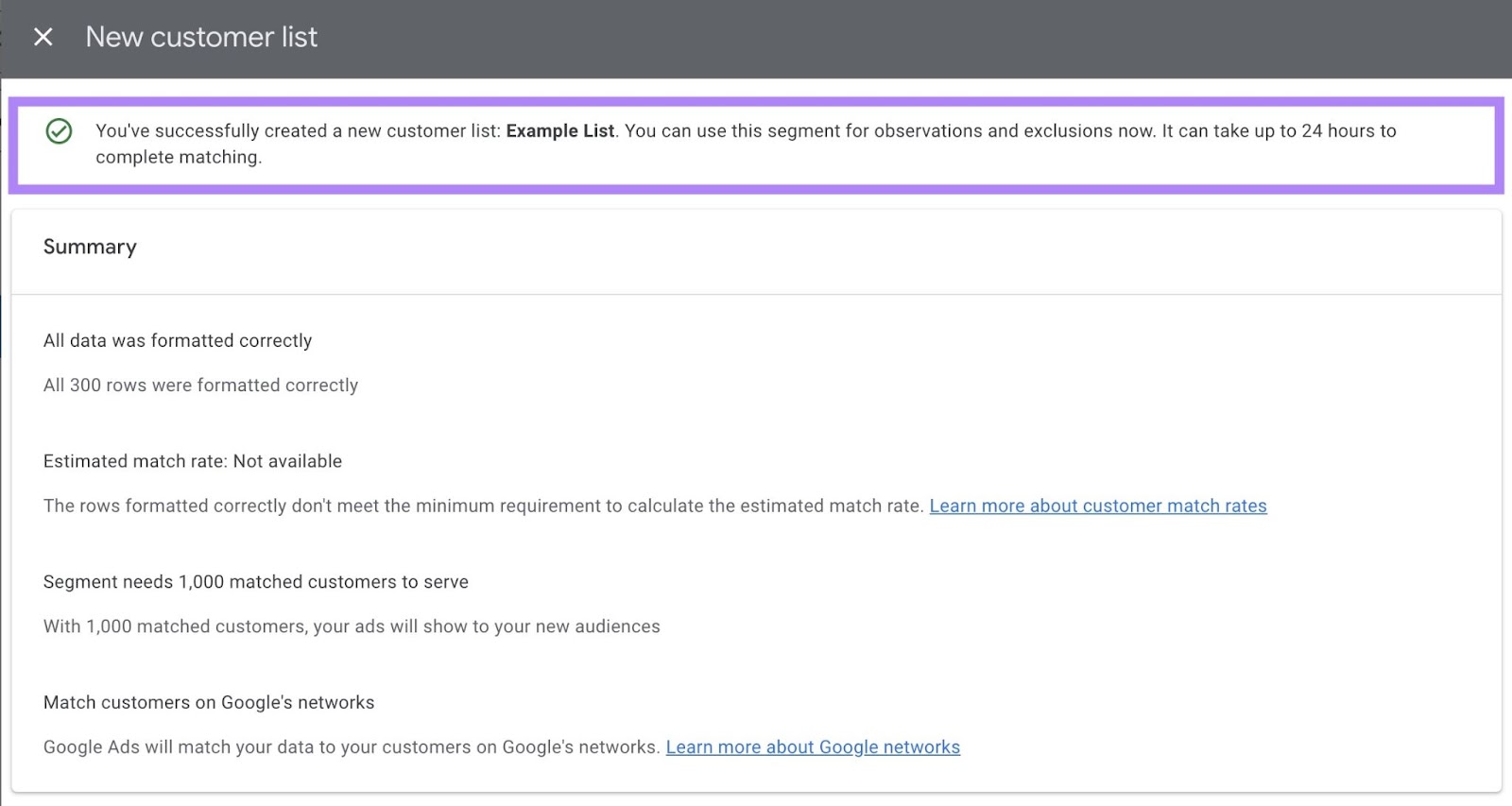
You need at least 1,000 matched customers to run remarketing ads.
Now, let’s create the remarketing ad campaign that you’ll run to target your customers.
Create an Ad Campaign
Click on the “+” from your Google Ads dashboard and select “Campaign.”
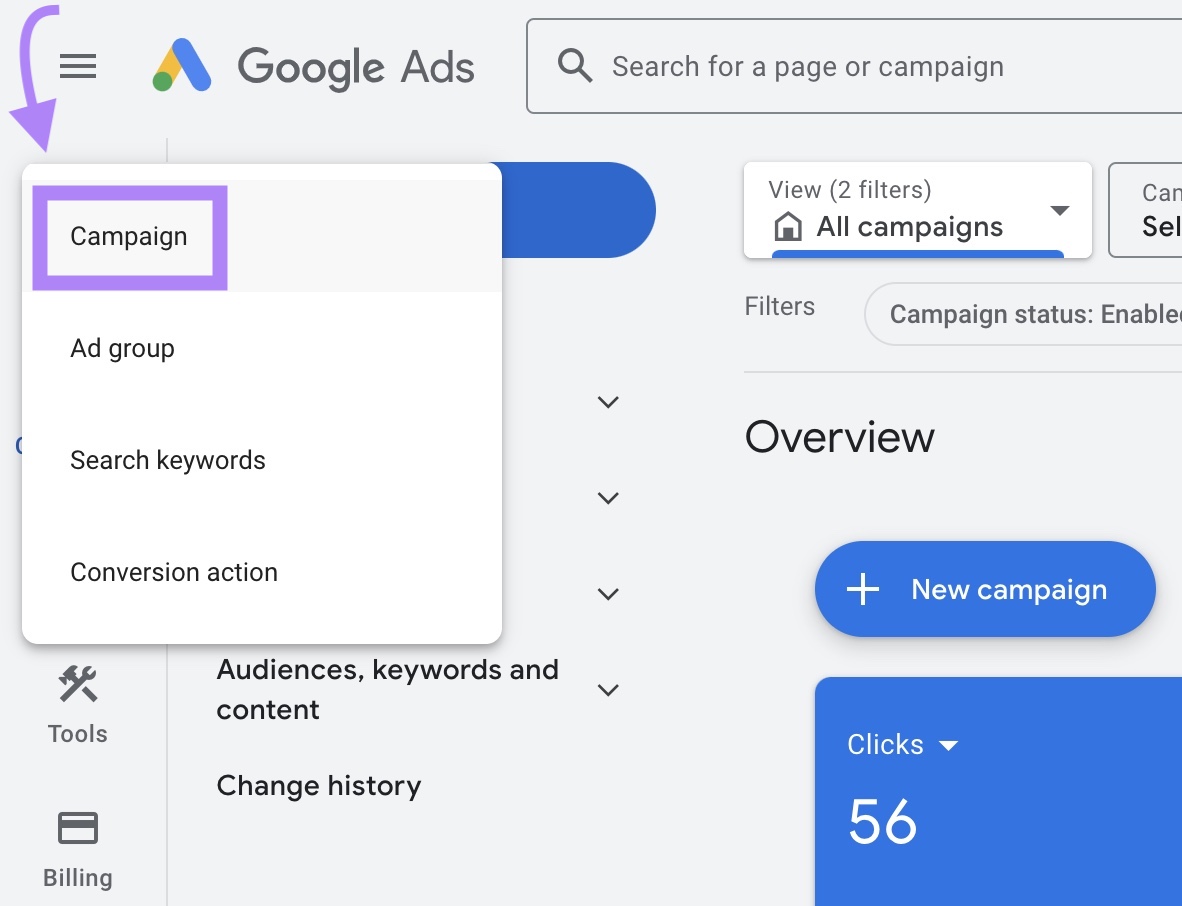
In your campaign’s objective, choose “Create a campaign without a goal’s guidance.”
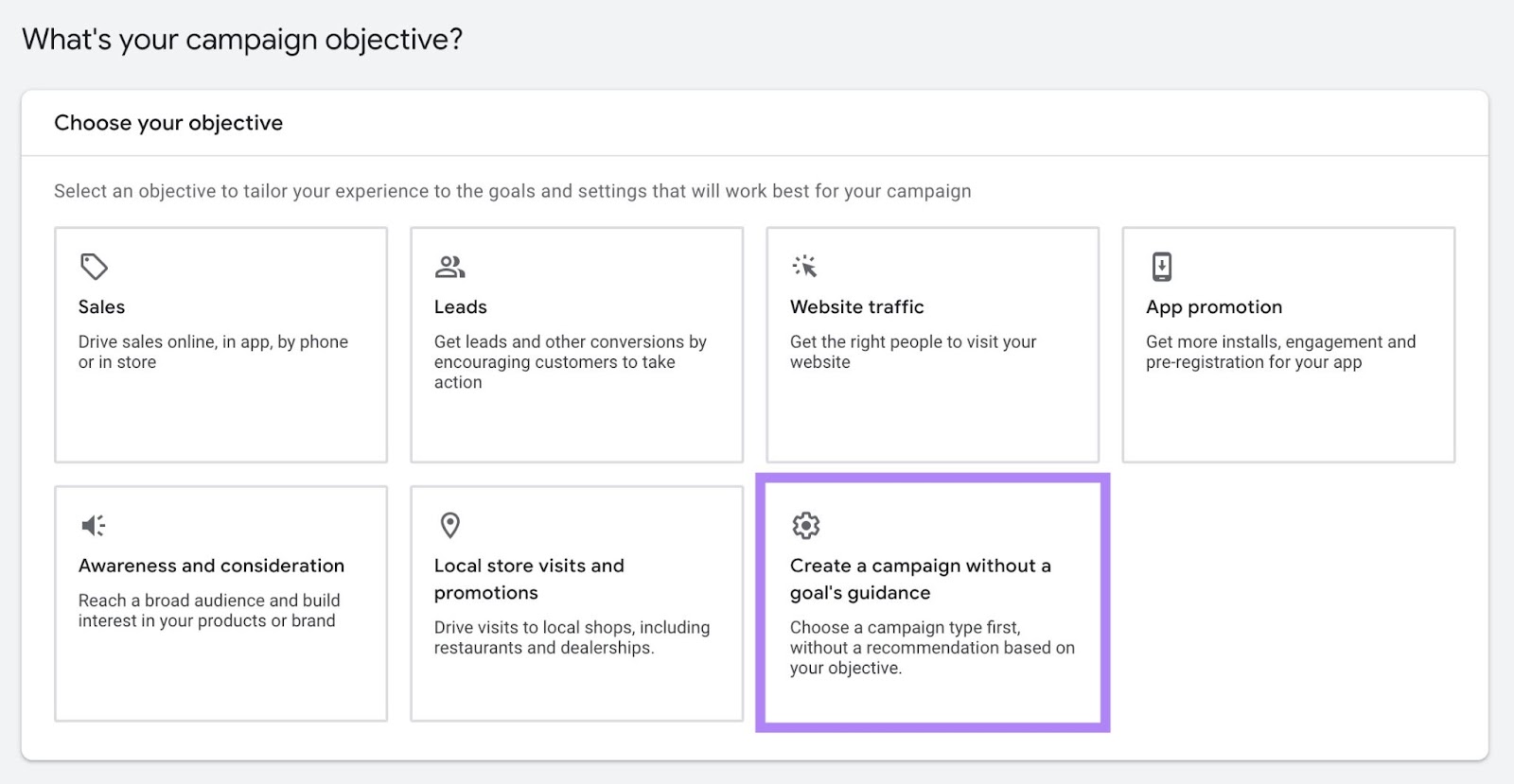
Select your campaign type. Remarketing ads are typically display ads. So, let’s go with “Display.”
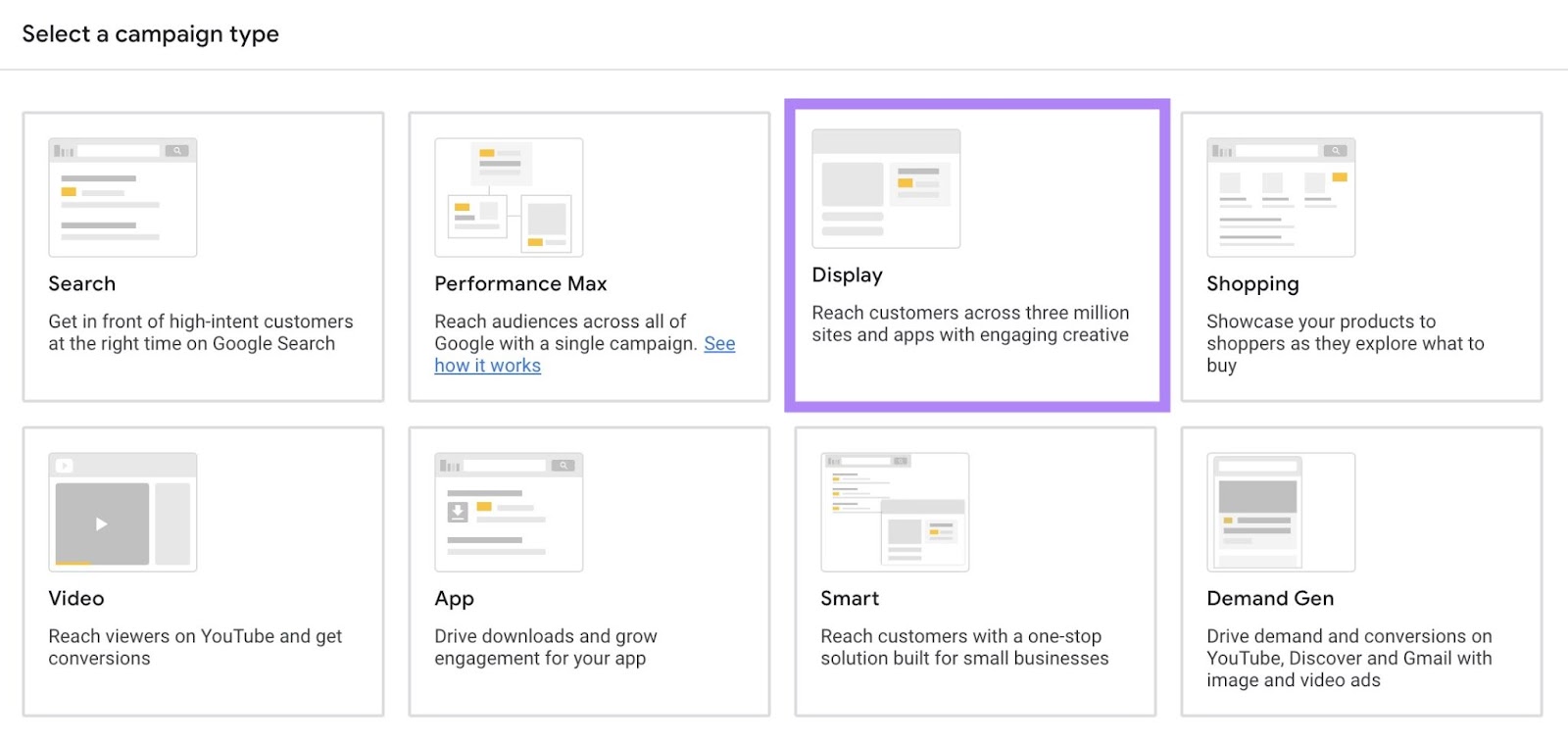
Select your conversion goal, add your business’s website, and give your campaign a name. Hit “Continue.”
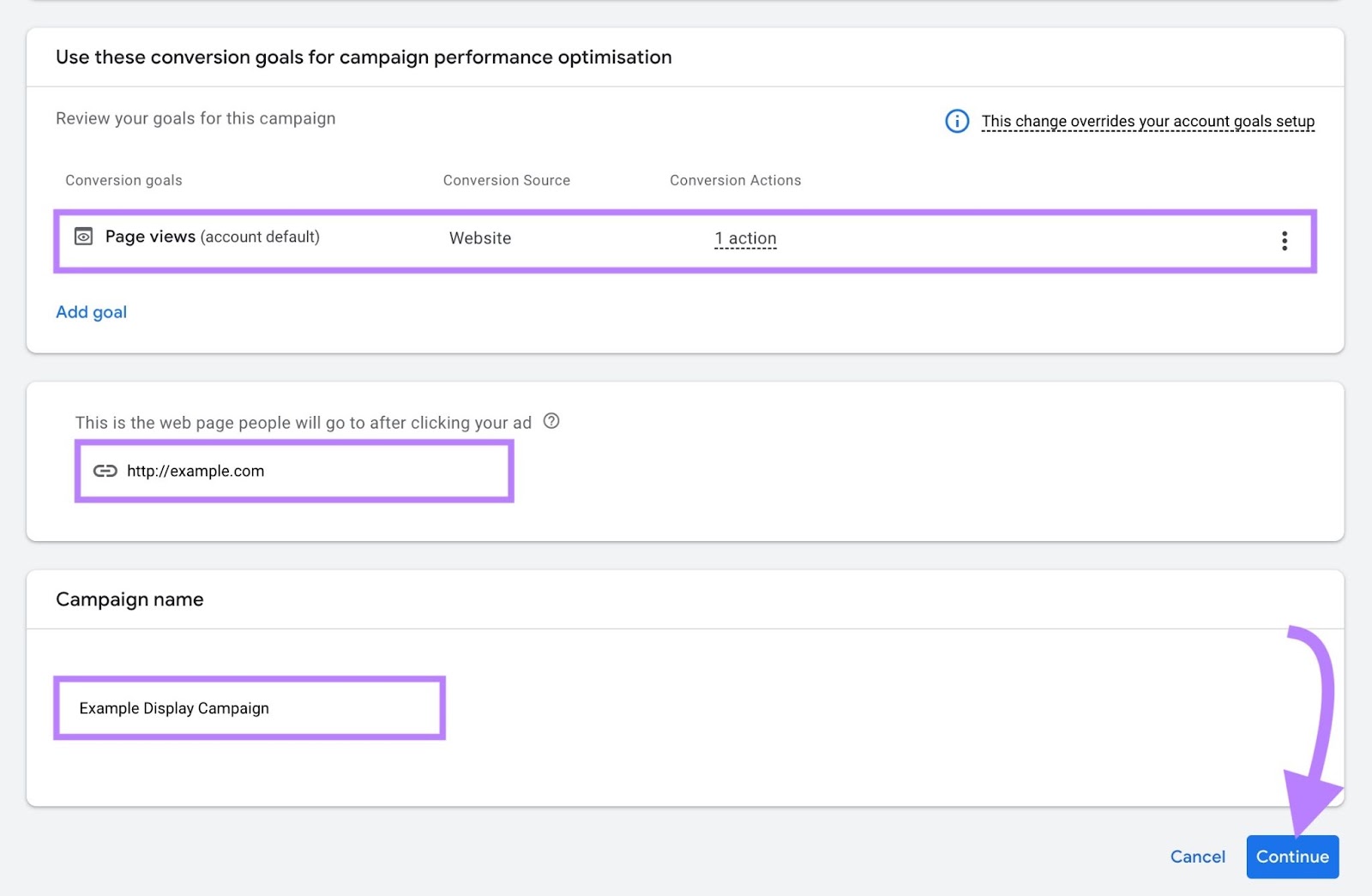
Next, configure your campaign settings. Which includes:
- Choosing the target location and language
- Setting your daily budget for the campaign
- Selecting your bidding strategy. Which tells Google Ads how to spend your budget to get the most clicks or conversions.
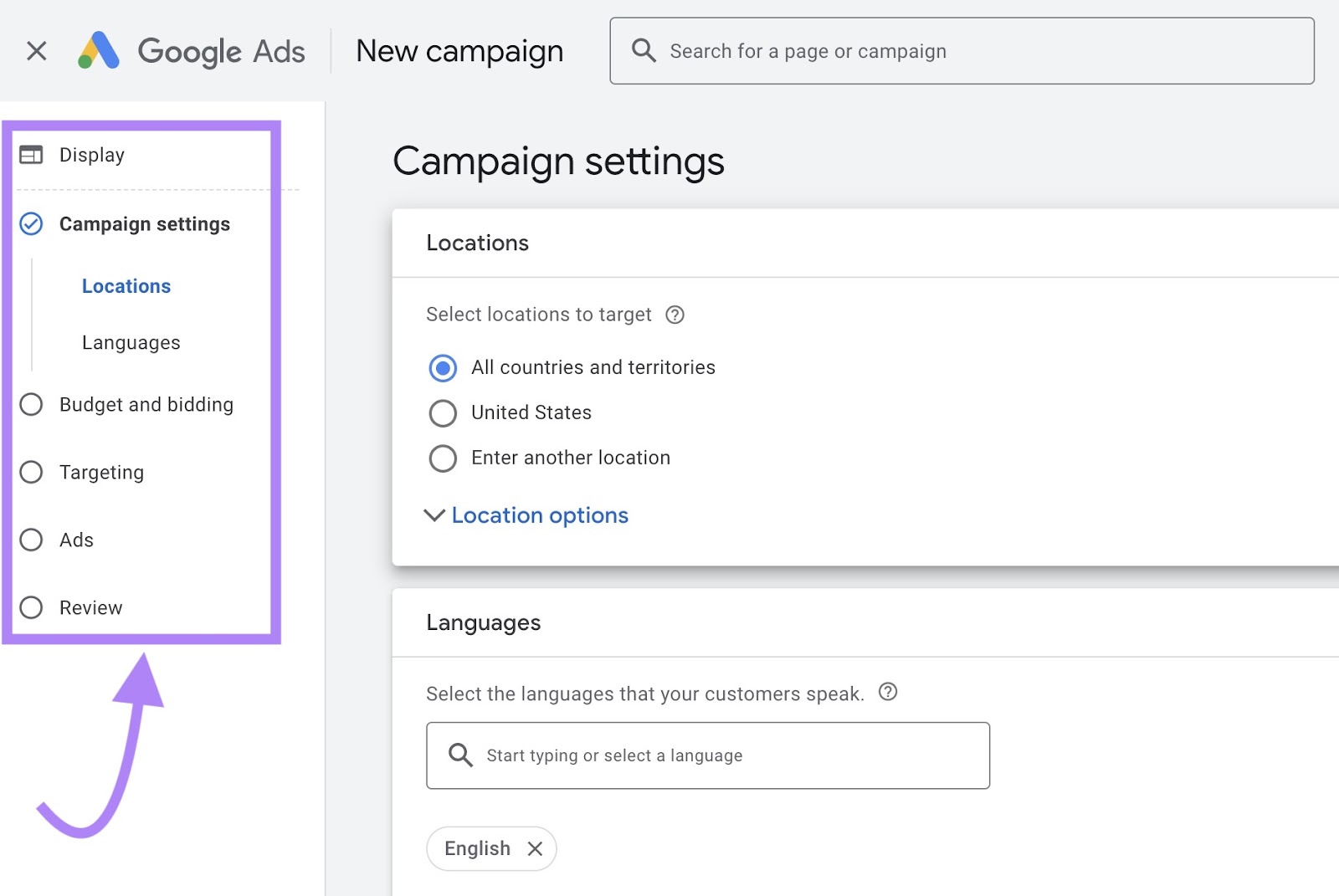
Go to the “Targeting” section and click “Add targeting.”
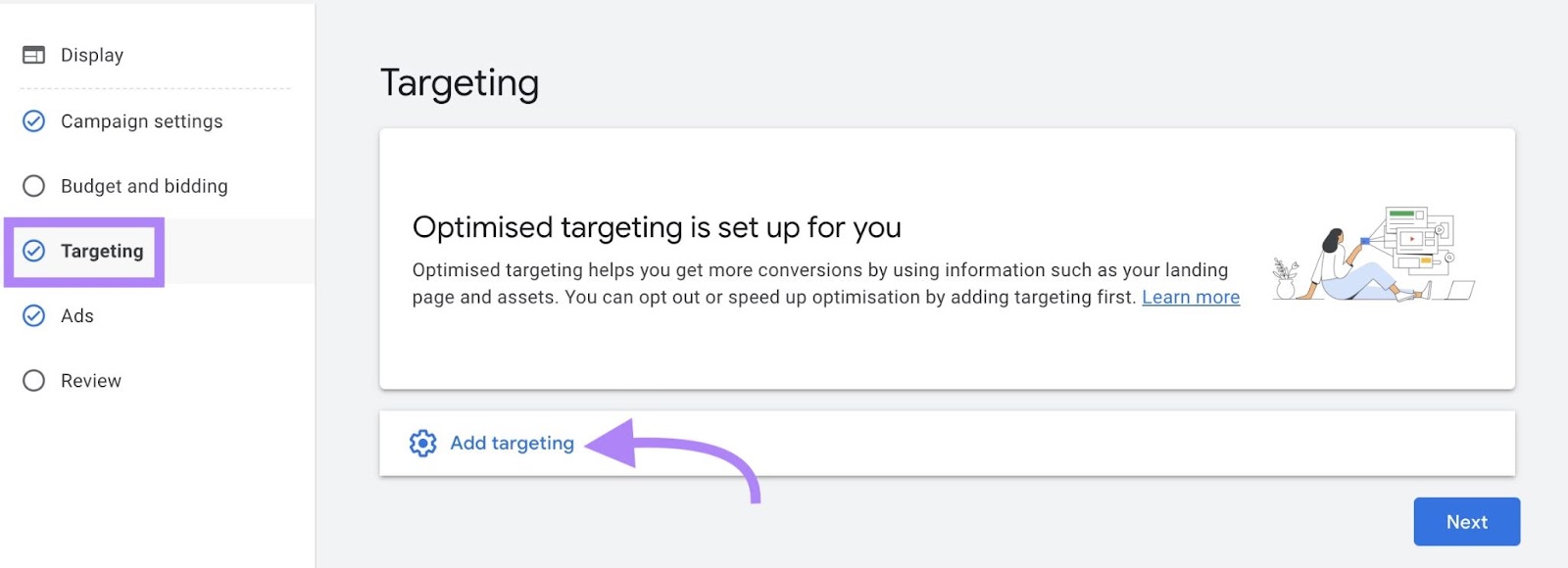
Select “Audience Segments” from the list of targeting options.
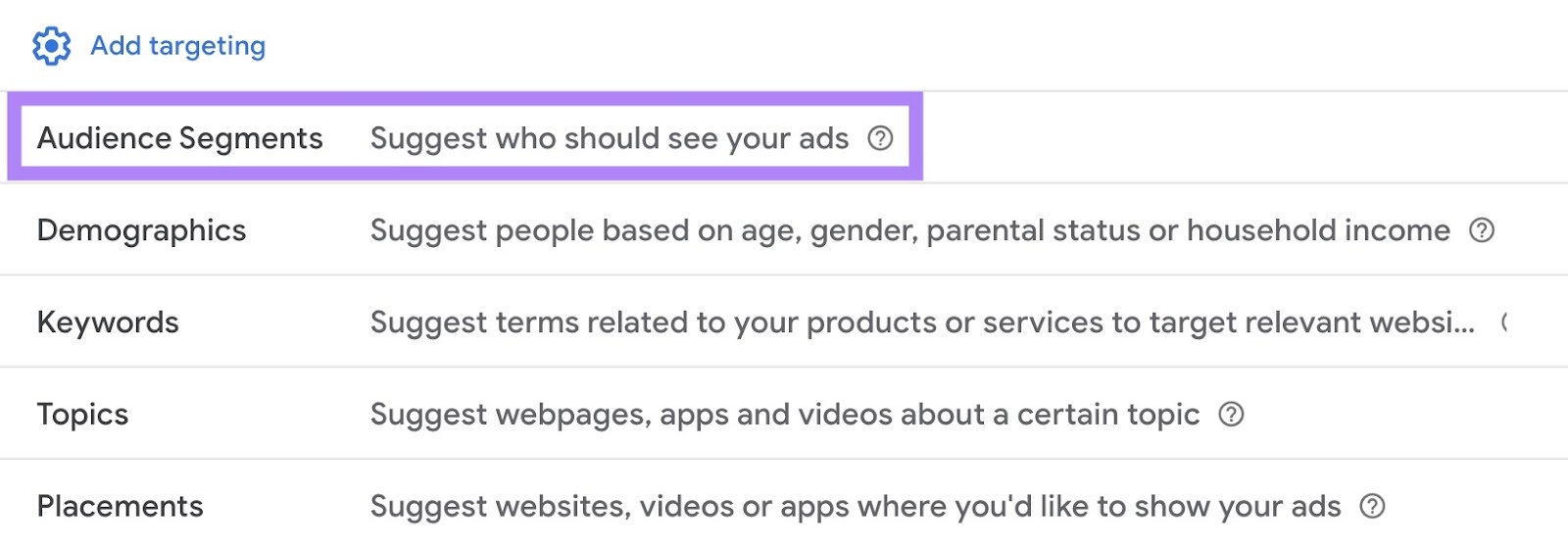
Go to the “Browse” tab and select “How they have interacted with your business.”
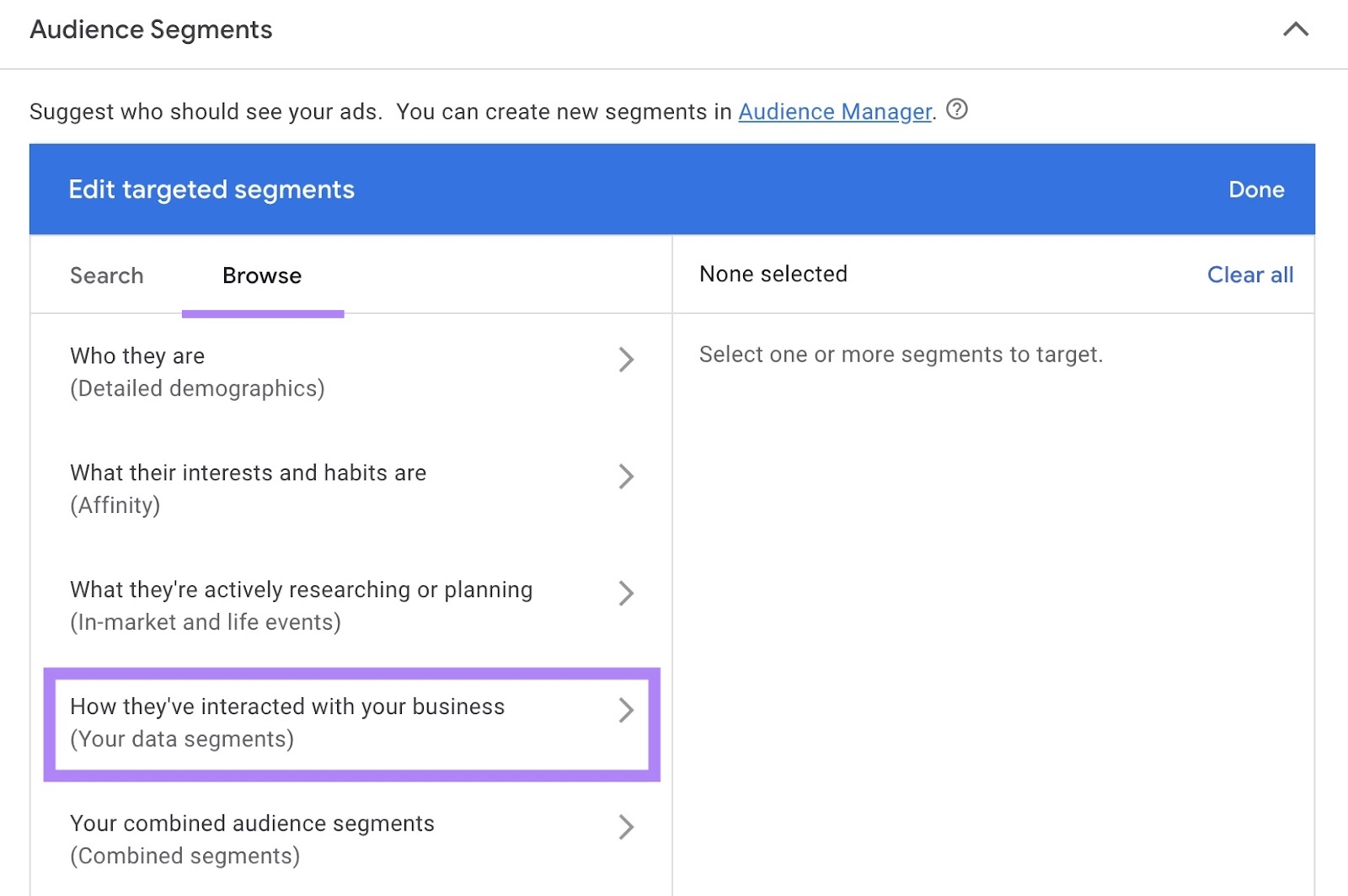
You’ll see the remarketing list you previously created. Select it and click “Next.”
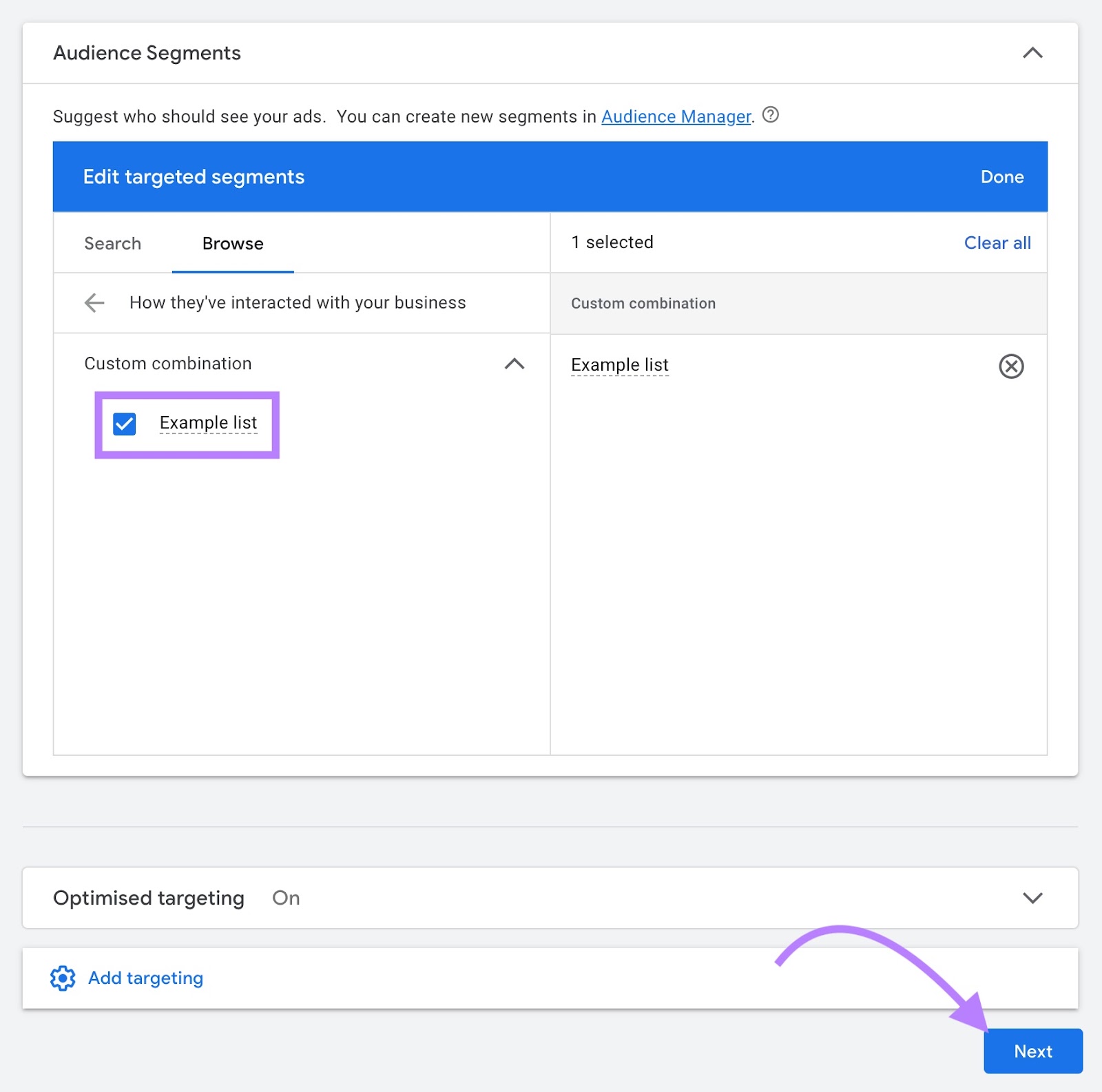
Next, create your ad. Which includes adding images, ad copy, descriptions, logos, and videos (optional).
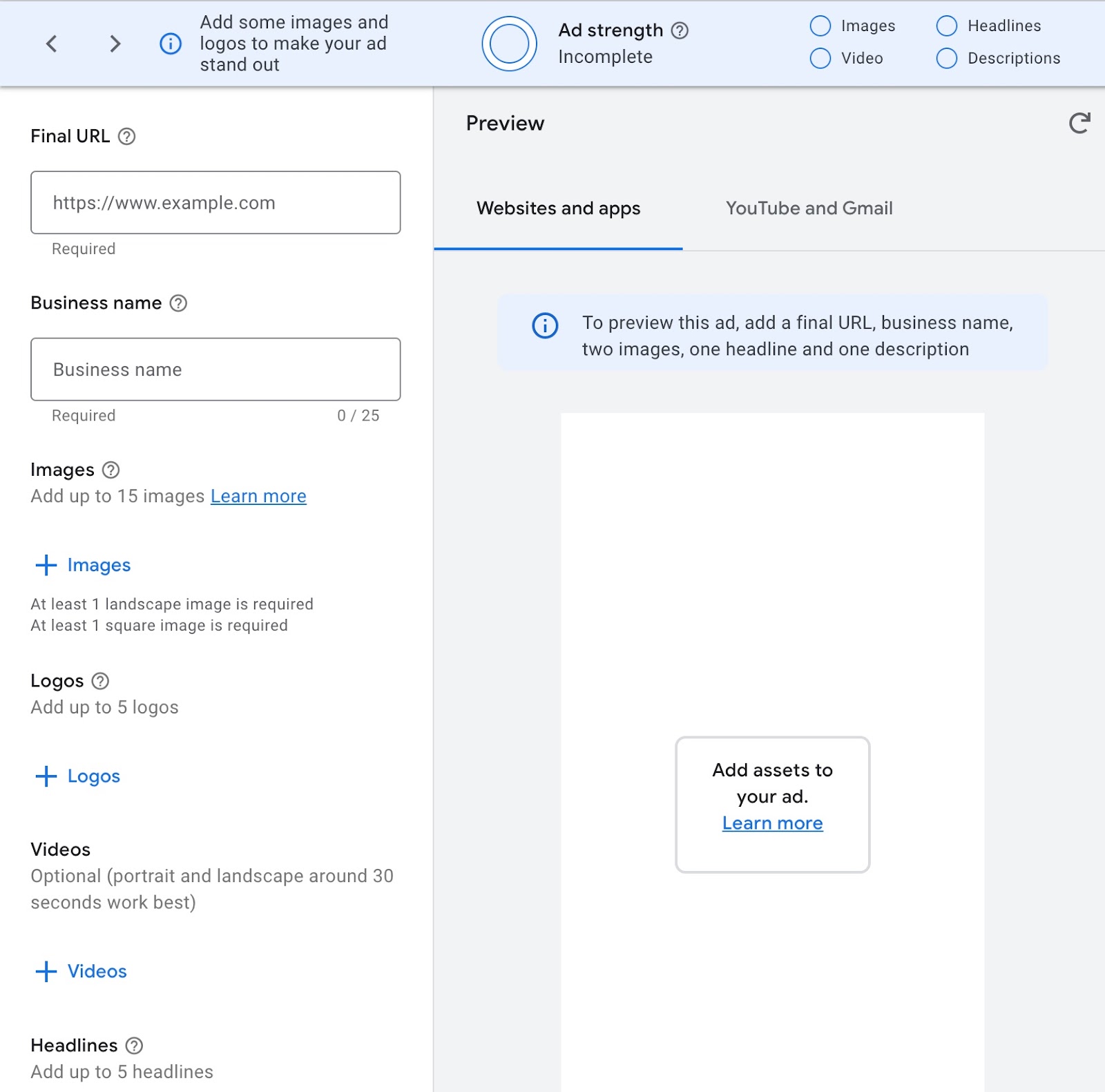
Finally, review your campaign and make it live.
Follow these tips to target your existing customers effectively with remarketing ad campaigns:
1. Find Out More About Your Customers
Understanding your customers better helps you create more relevant ad campaigns.
You already have basic customer data based on their purchase history. Including their location and preferred products.
Use this information to personalize your campaign.
In addition, gaining more insights into your audience’s demographics, socioeconomics, and behavior will tell you:
- What might interest your customers
- What device they use predominantly
- Which social media platforms they spend most of their time on
Gather these insights by looking at your competitors’ audience base. They likely have the same audience as you.
Use our One2Target audience analytics tool to analyze competitor domains. Enter your competitors’ URLs and click “Analyze.”

It will analyze your competitors’ audience and give you four reports: Demographics, Socioeconomics, Behavior, and Audience Overlap.
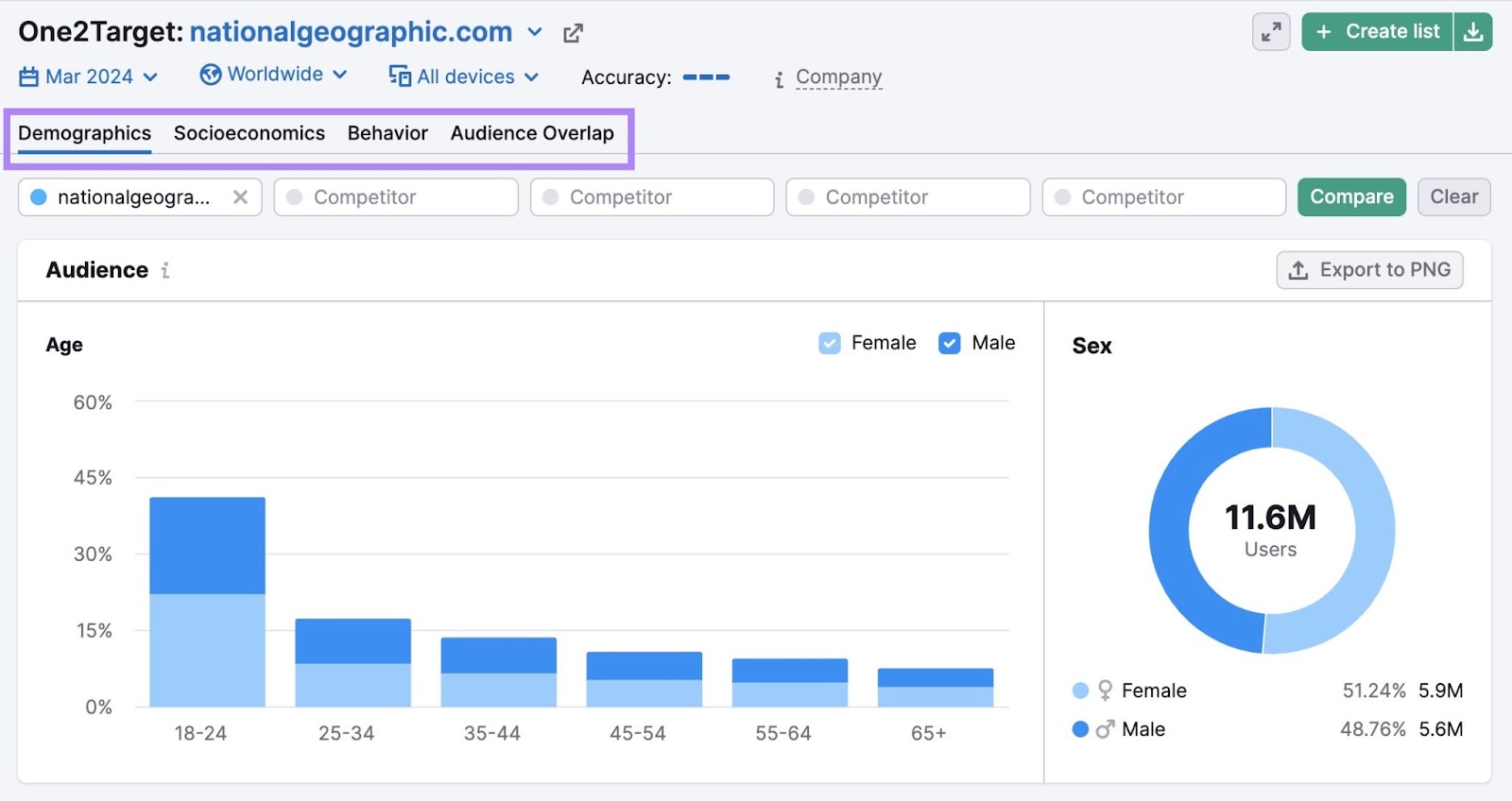
Go to the “Behavior” tab and scroll down to the “Interests” and “Social Media” sections.
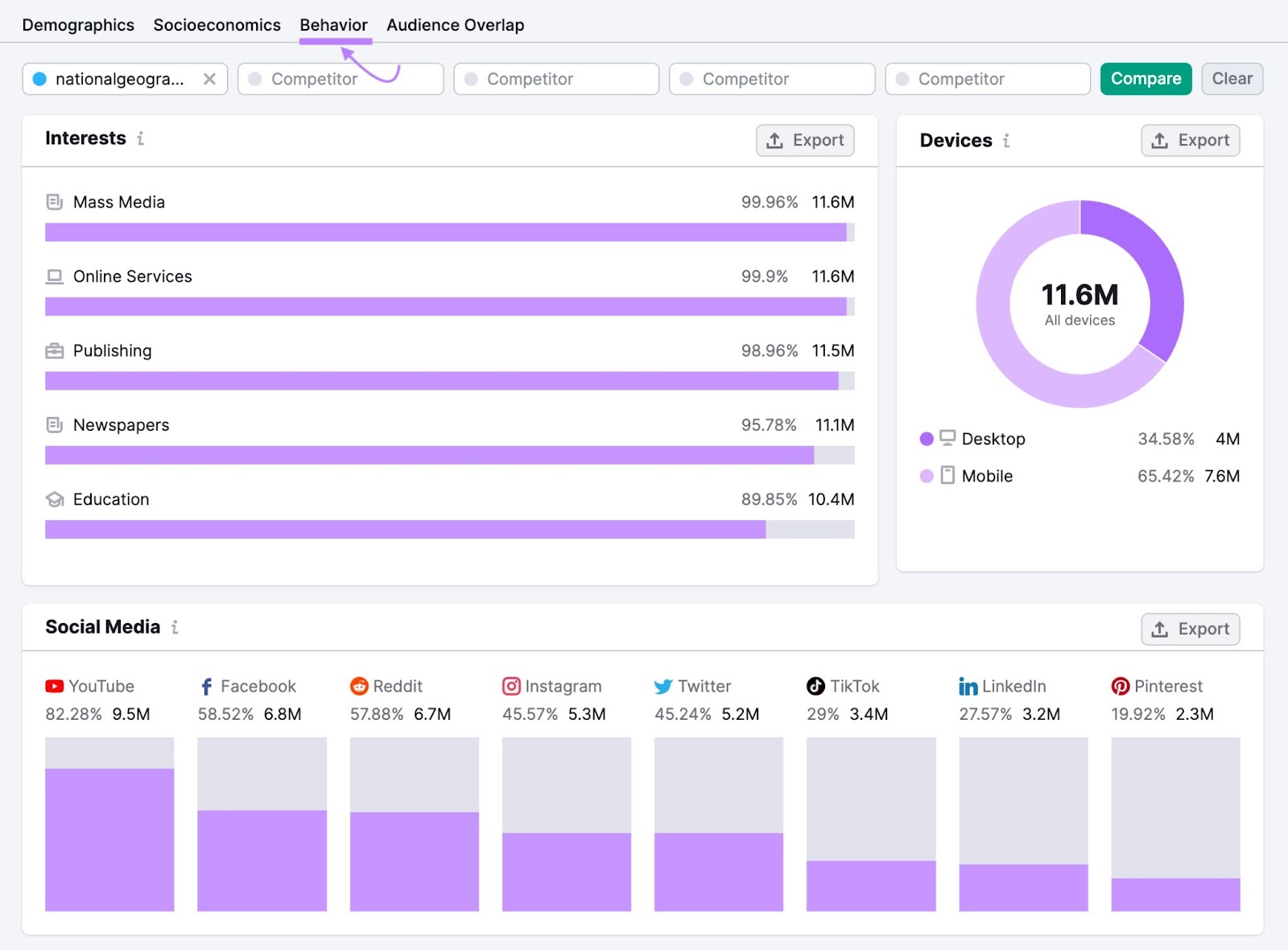
Use these data points to enrich your customer database. This will help you align your remarketing campaign with who your customers are, where they spend their time the most, and what they prefer.
For instance, if you find your shared audience spends more time on YouTube than on LinkedIn, it’s a good idea to run your remarketing campaign on YouTube.
Similarly, if you find that your shared audience likes a specific topic or uses mobile to access the web, you can design your ad campaign accordingly.
2. Learn from Your Competitors
Finding out which channels bring the most traffic for your competitors can help you decide where to focus your own remarketing efforts.
For example, if a competitor gets a lot of paid traffic from Facebook, it might be a good platform for your remarketing ads, too. Your shared audience (which includes your existing customers) is likely more active there.
Also, look at your competitors’ most popular webpages. Which ones get the most visits and keep people engaged the longest?
Analyzing these pages can spark ideas for your own remarketing landing pages.
Pay attention to the messaging, visuals, and offers on their top pages. How do they capture attention and persuade visitors to take action?
Use these insights to create remarketing landing pages that resonate with your shared audience.
Use our Traffic Analytics tool to analyze your competitors’ website traffic.
Open the tool, enter up to five competitors’ domains, and click “Analyze.”

You’ll see an overview report like this:
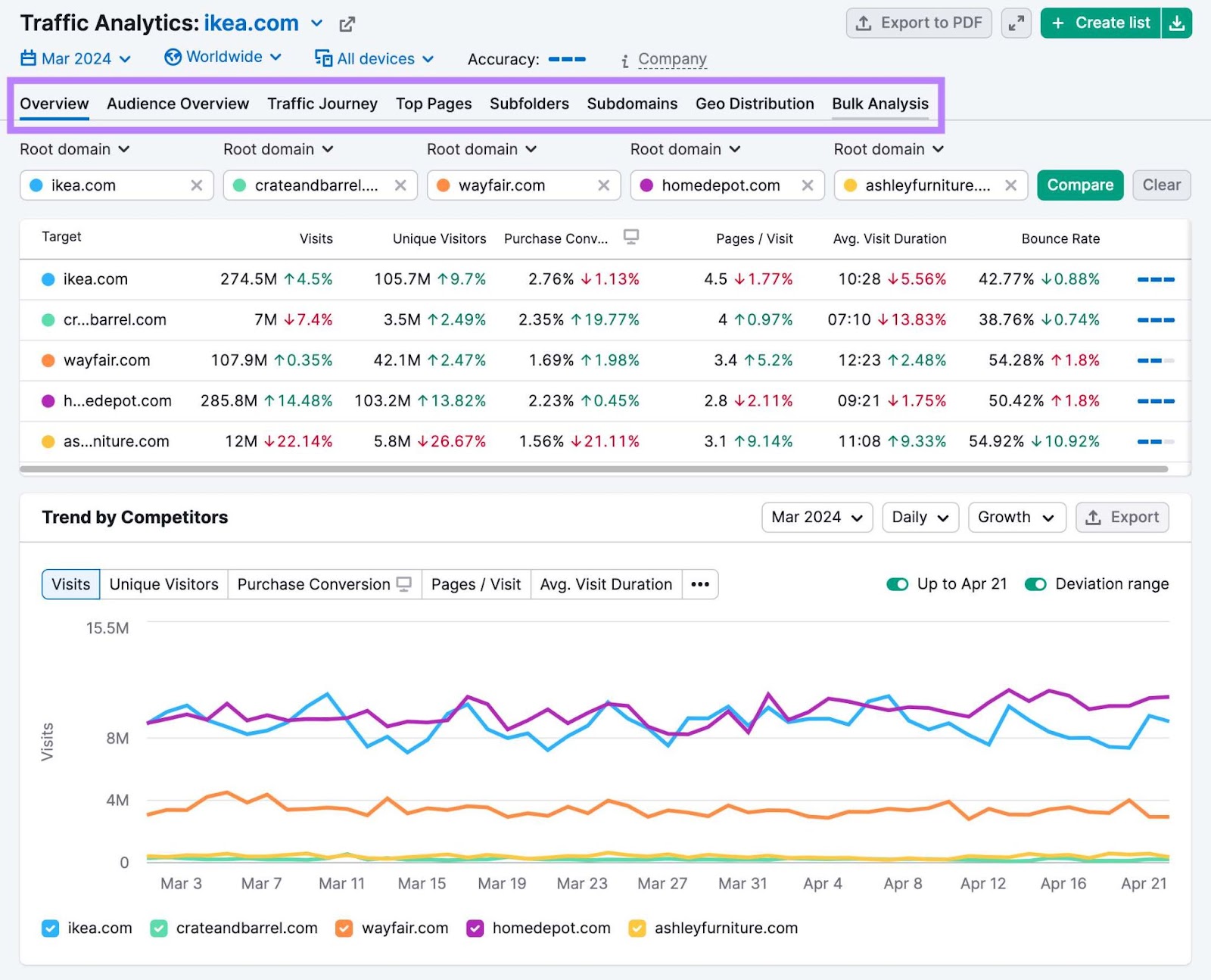
Go to the “Traffic Journey” tab and scroll down to look at the “Traffic Channels” section.
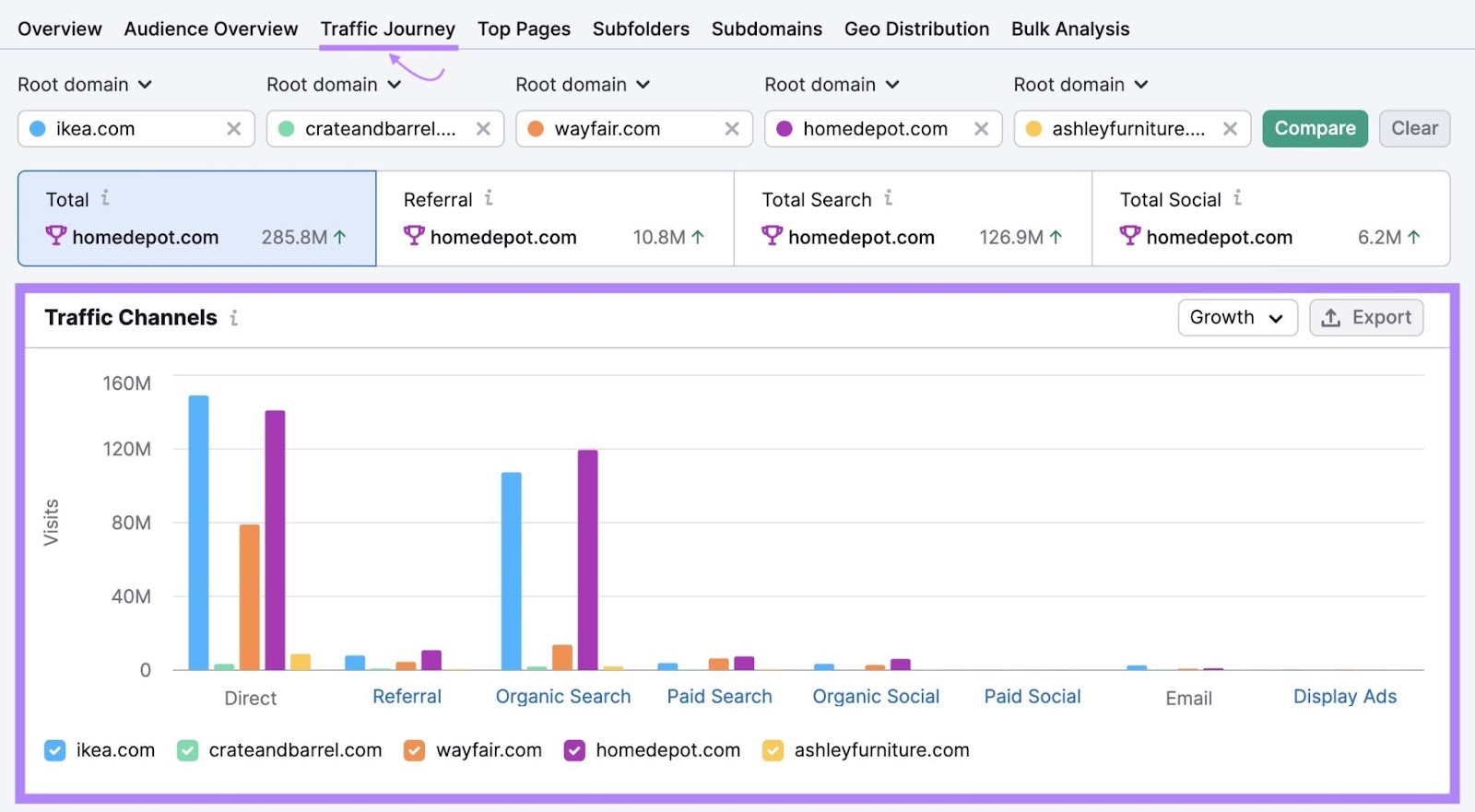
Look at which channels are driving the most traffic to your competitor. They might be good options to focus on in your remarketing campaigns.
Next, go to the “Top Pages” tab and scroll down to see the most popular pages on their website.
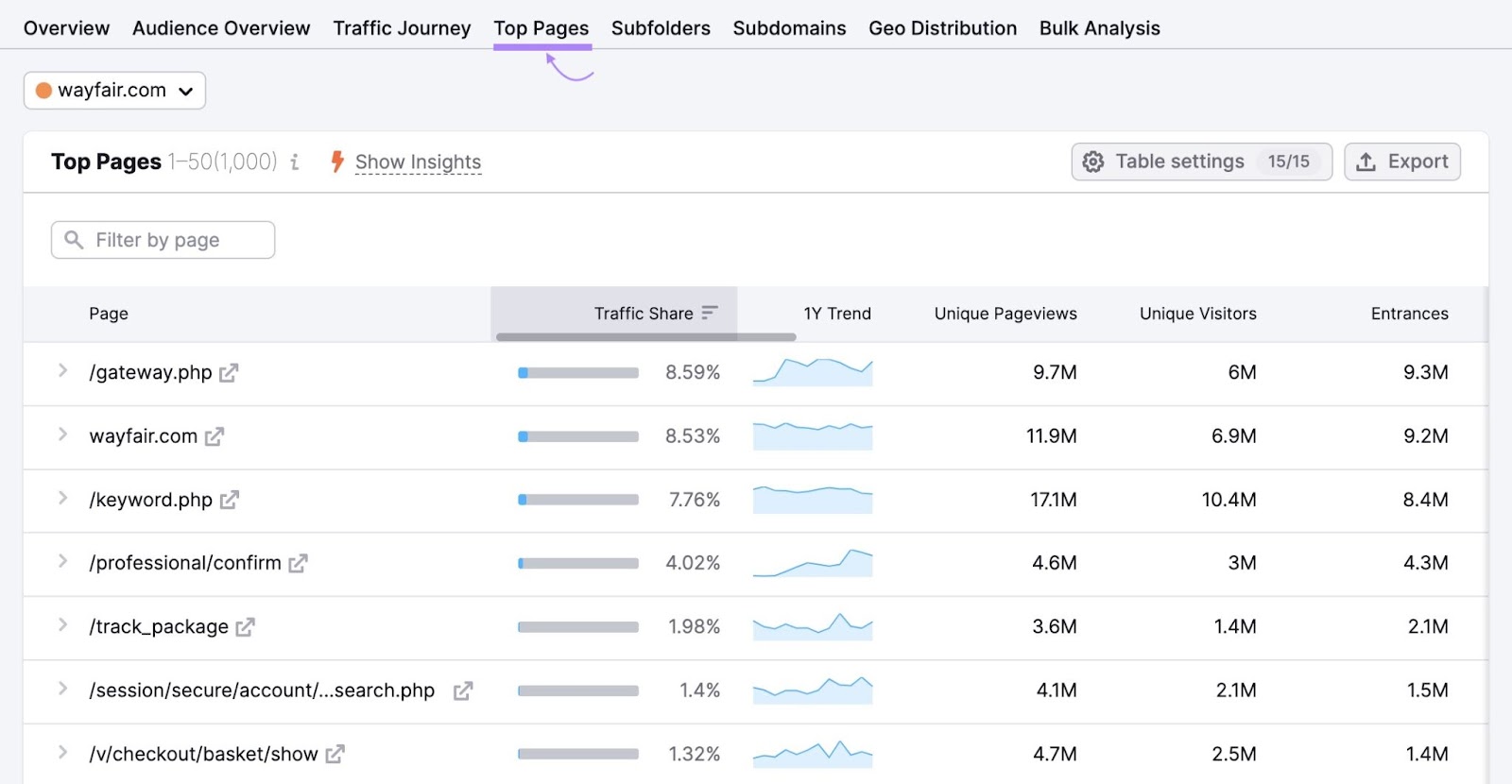
Pay attention to their product pages getting the most unique visitors.
Look at the pages individually to see how they look and what type of messaging they have.
Consider running ads for similar products in your remarketing campaign (since they are very popular among your shared audience). Use similar design and messaging.
Dynamic remarketing shows ads that include the specific items a customer looked at on your website. If a customer was browsing blue sneakers, your ad would feature that exact pair of blue sneakers.
This level of personalization grabs attention instantly. And reminds visitors exactly what caught their eye, encouraging them to return. And make a purchase.
To set up dynamic remarketing ads:
- Create a product feed: A product feed is a file (usually in XML or CSV format) that contains details about your products. Such as ID, name, description, price, image URL, and more. This feed allows ad platforms to pull the relevant product information to display in your dynamic ads.
- Add dynamic remarketing tags to your website: These are small pieces of code you place on specific pages of your site, such as product pages. To track visitor behavior and send the product information to your ad platform. The tags help match the right products to the right visitors.
- Set up dynamic ad templates: On your chosen ad platform, create ad templates that will automatically populate with the relevant product information from your feed. Based on each visitor’s interactions with your site.
Run this dynamic remarketing ad campaign with your uploaded remarketing list as the target audience.
4. Experiment with Different Ad Formats
Ad platforms offer several formats for remarketing. Such as responsive display ads that automatically adjust their size and appearance to fit different placements.
Try these different ad formats to assess what works best for your target audience.
For instance, you may discover video ads excel at explaining your products. Like this Shopify ad:
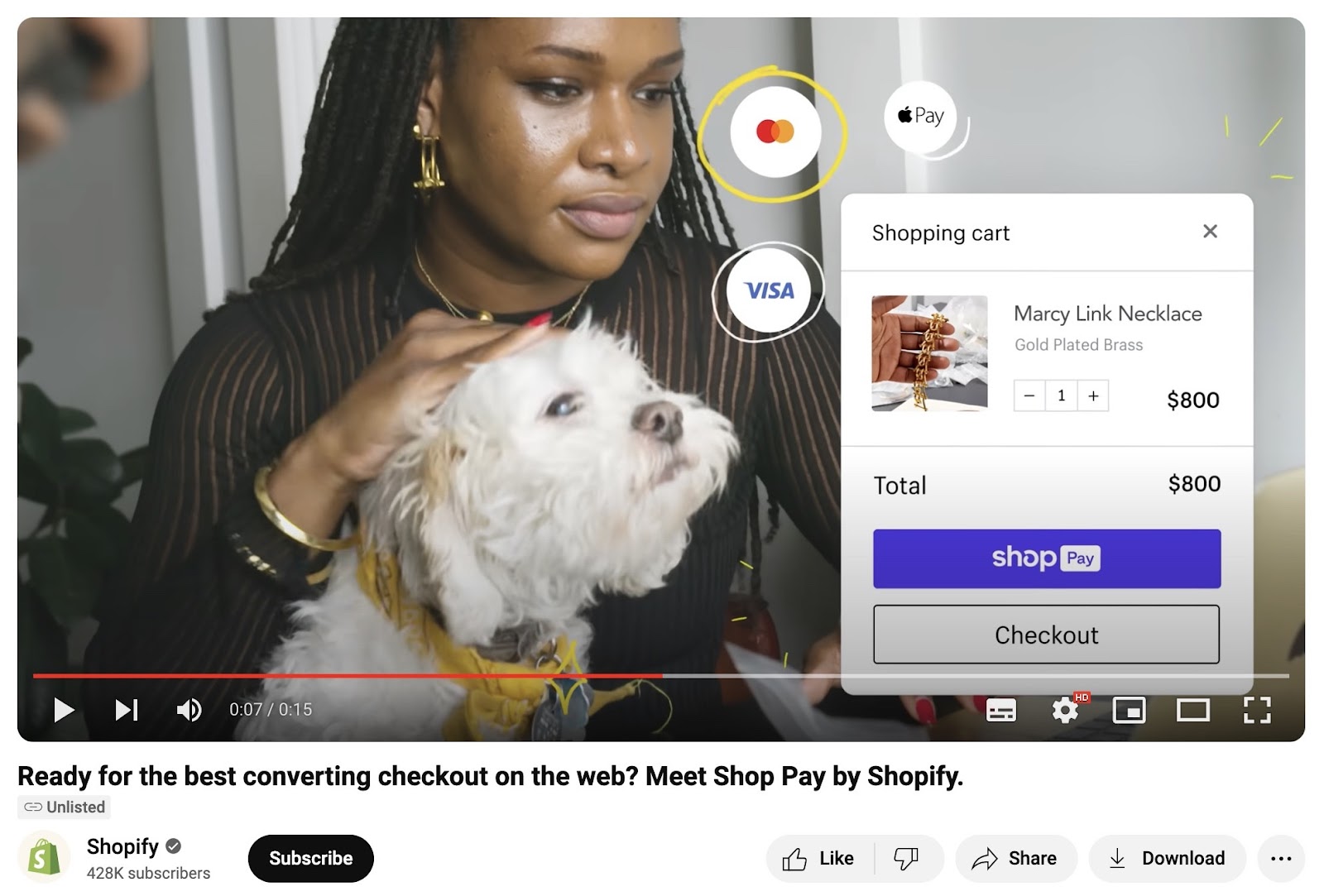
And simple image ads may drive more site traffic. Like this one from Mailchimp:
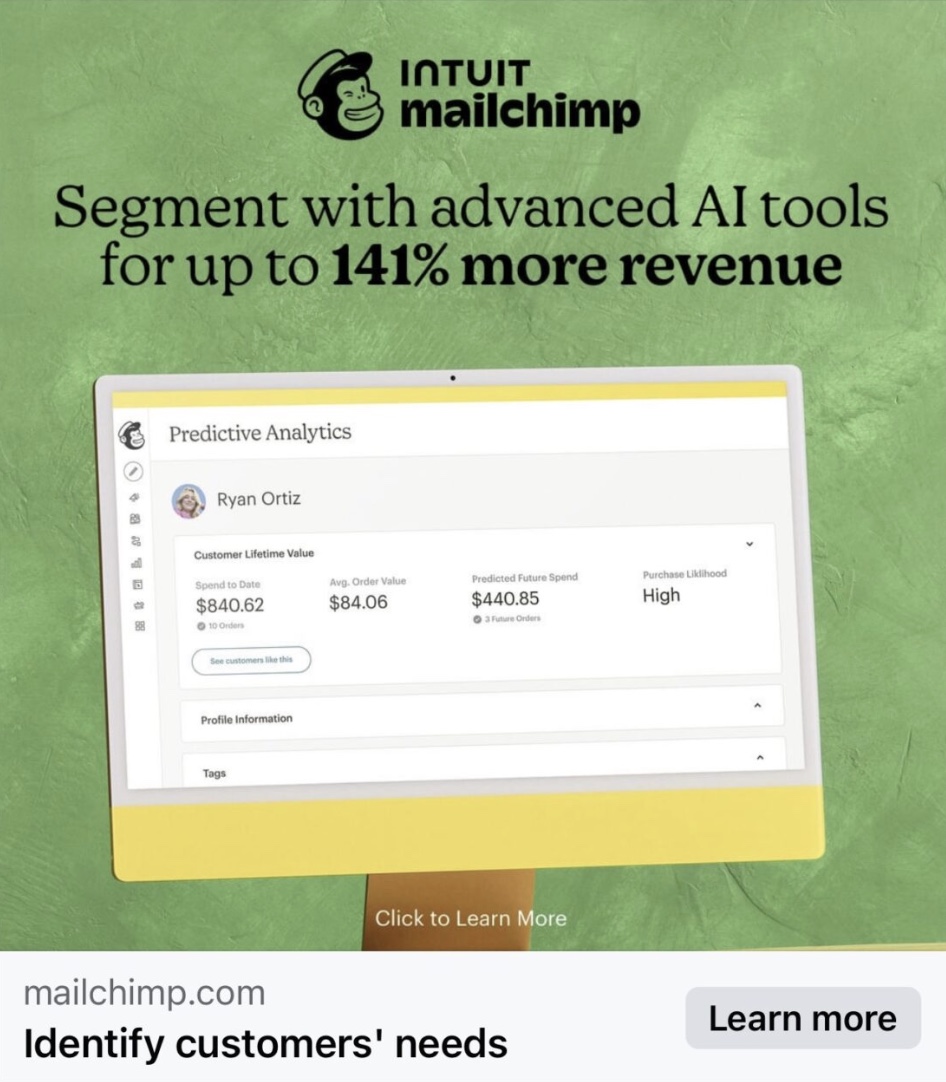
See what performs best in your niche.
The goal is to test different options to find what generates the highest engagement and conversions from your existing customers.
Segmenting your remarketing lists lets you show more relevant ads to different groups of customers.
Create segments based on factors like what products they bought, how much they spent, or how recently they made a purchase.
For example, you could manually create separate lists for customers who bought from you in the last 30 days, last 60 days, or last 90 days.
This way, you can tailor your messaging and offers to each group’s specific needs and interests.
6. Implement Frequency Capping
Frequency capping allows you to limit how often each customer sees your ads.
You control the frequency by setting a cap for the maximum number of impressions you want to serve to each person over a given time frame.
For example, you can decide to display your ad to someone at most three times per week. This keeps your brand in customers’ minds without causing fatigue.
Major advertising platforms allow you to configure frequency caps according to your preferences. Like Google Ads here:
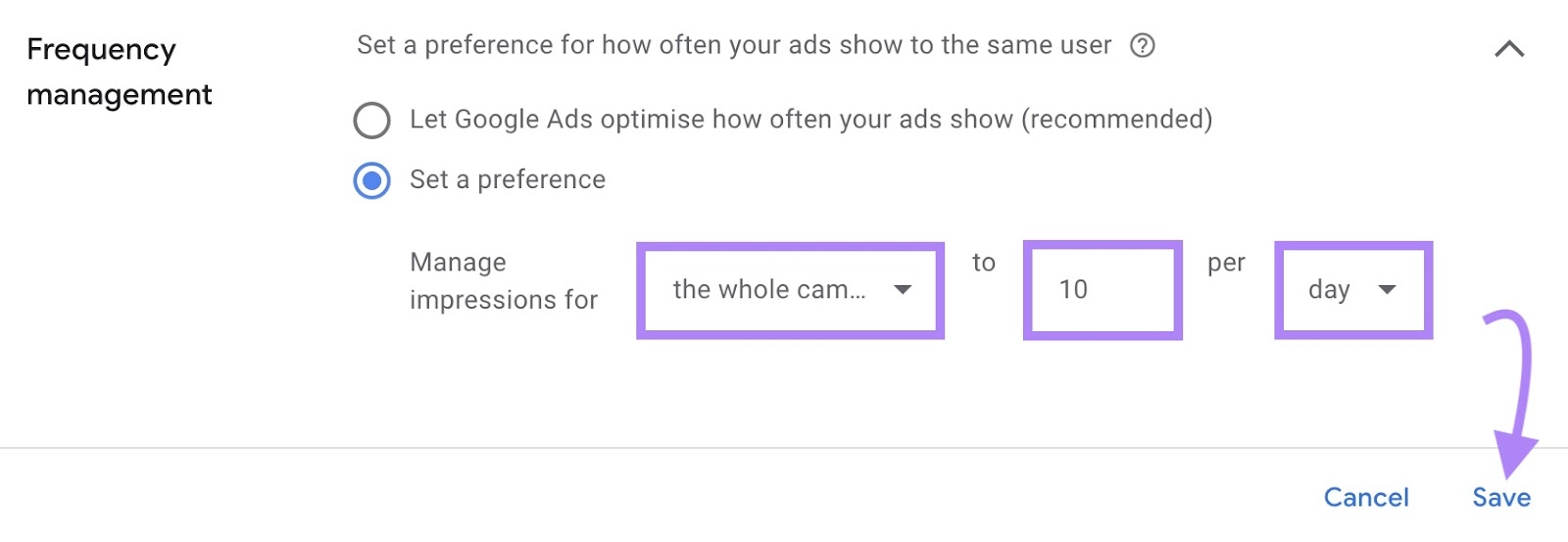
7. Monitor, Test, and Adjust Your Campaigns
Review your campaign metrics constantly to optimize ad performance based on data.
Use analytics tools to track important metrics. Like click-through rate, conversion rate, return on ad spend, and repeat purchase ratio.
Then, make decisions and refine your strategy using this data.
For instance, if parts of your campaign are underperforming, try A/B testing new variations to boost your results.
Remarketing takes continuous monitoring and fine-tuning. But it provides an excellent opportunity to keep revenue flowing from your existing customer base.
Acquiring new customers can take a lot of time and money. Don’t let them disappear after one purchase.
Reengage your existing customers. And encourage them to buy from you again.
A well-planned remarketing campaign can help you do this.
But before you create your ads and landing pages, analyze your competitors to see what works for them. And what’s preferred by your shared audience. Then, use these insights to build your campaign.
Start by looking into your competitors’ landing pages and traffic sources with Traffic Analytics.
